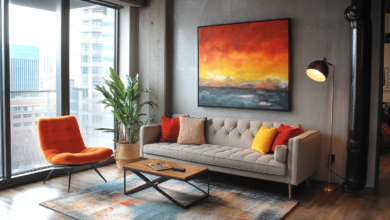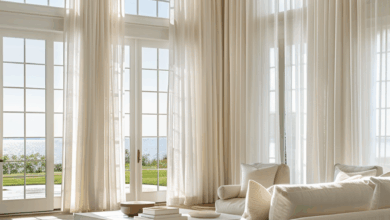Dive Into Luxury: 63 Stunning Freestanding Tubs That Transform Relaxation from Zen to Avant-Garde
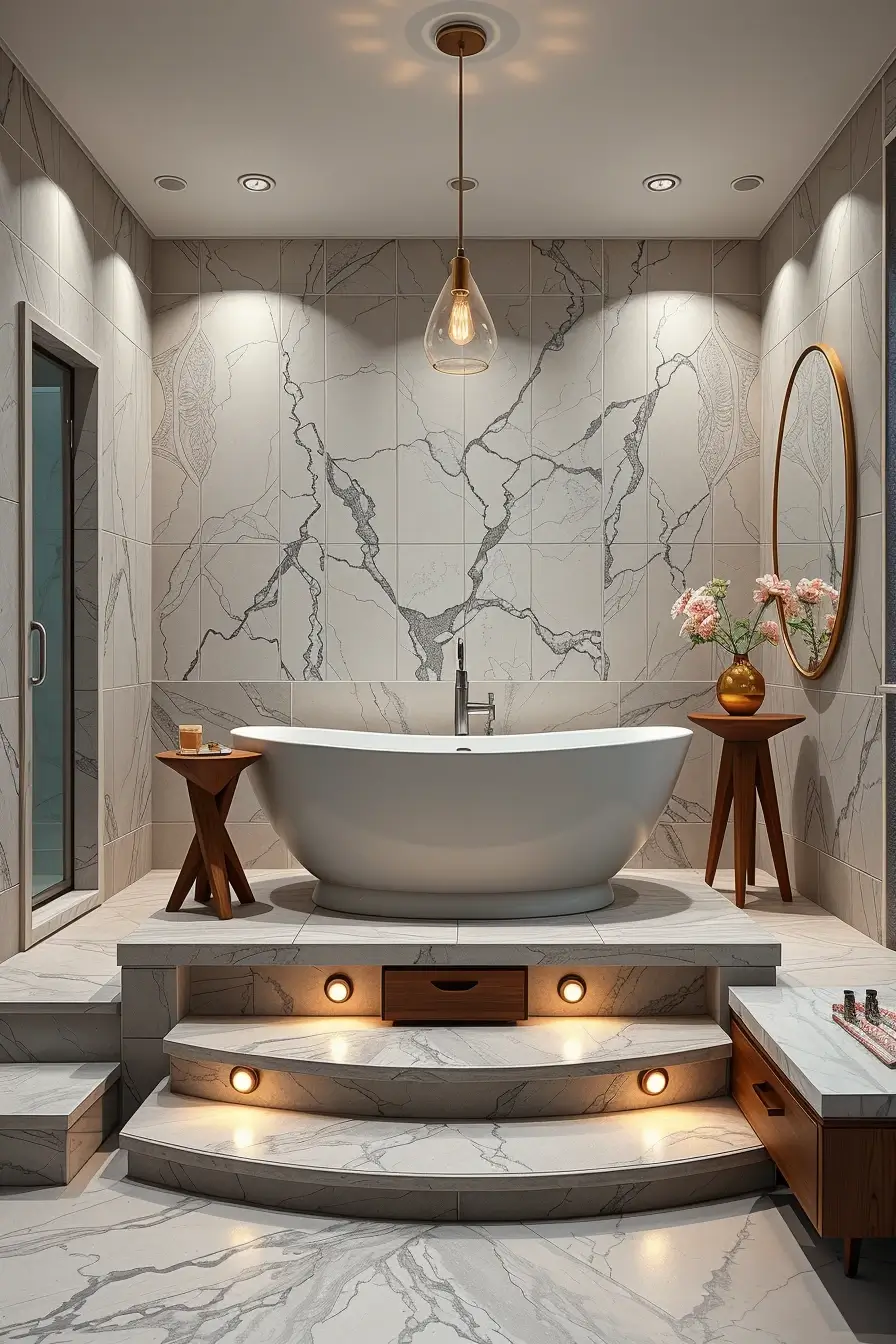
Are you searching for the ultimate way to unwind while elevating your bathroom’s aesthetic? Imagine if your freestanding bathtub wasn’t just a place to soak but a transformative centerpiece that enhances your entire bathroom’s ambiance. In this guide, I’ll showcase 63 stunning freestanding tub designs that blend opulence, innovative style, and practicality-ranging from serene Zen-inspired simplicity to bold avant-garde masterpieces. Whether you prefer the tranquil charm of Japanese soaking tubs, the sleek allure of matte black finishes, or the futuristic appeal of transparent glass tubs, each design redefines relaxation. Let’s dive into the latest luxurious freestanding bathtub trends and explore how they can turn your bathroom into a spa-like sanctuary.
Embracing Zen Minimalism: Tub Designs for Tranquil Spaces
When crafting a mindful bathroom, I prioritize simplicity as the cornerstone of design. Here, the freestanding tub serves as the room’s centerpiece, embodying calm and clarity. Minimalist tubs with soft curves and matte finishes create a peaceful retreat by eliminating unnecessary distractions. A palette of cool tones, abundant natural light, and clean lines work harmoniously to foster relaxation.

A matte white stone resin tub with rounded edges fits perfectly in such a setting. Pair it with a teak bath caddy, a wooden stool, and soft linen towels to cultivate harmony. Complement the look with a ceramic vessel and subtle recessed lighting, accentuated by a single bamboo plant. I always recommend wall-mounted faucets to maintain a clutter-free visual flow.
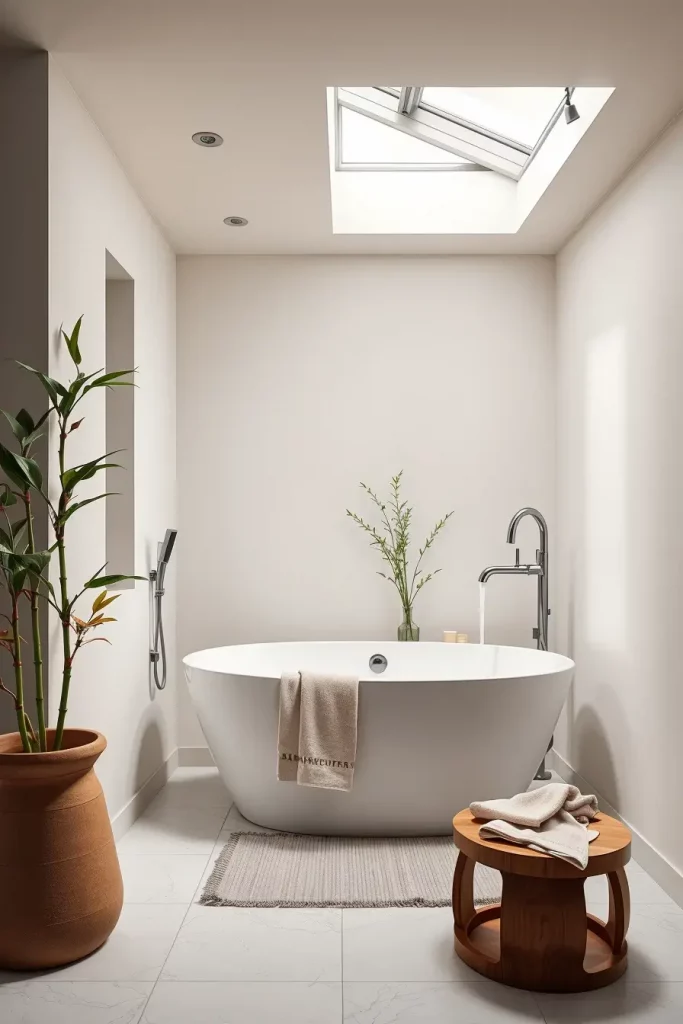
This style evokes the serene wellness spas of Kyoto, where calmness and intentionality reign. Architectural Digest highlights that minimalist design is not about deprivation but a deliberate commitment to clarity, enhancing the bathing experience. For added comfort, I suggest integrating underfloor heating and discreet built-in speakers playing ambient sounds-subtle upgrades that elevate the soothing atmosphere.
Artistic Sculptures: Freestanding Tubs as Bold Centerpieces
Some bathrooms demand more than tranquility-they call for a striking artistic statement. In these spaces, the freestanding tub transforms into a sculptural focal point, captivating attention like a gallery piece. Positioned prominently, these designs emphasize dynamic curves, unexpected shapes, and luxurious finishes to create drama.
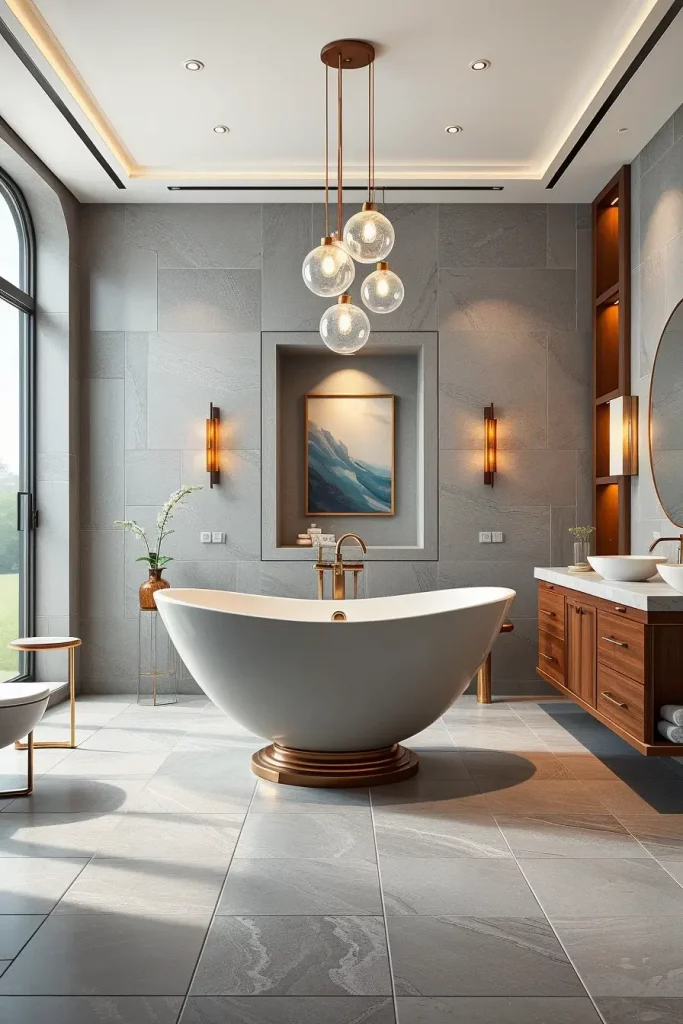
My favorites are organically shaped resin or solid-surface tubs with metallic or marble finishes, often elevated on pedestal bases like museum exhibits. Surrounding elements should remain minimal-floating wood vanities, frosted globe pendant lights, and large-format stone tiles in soft gray or travertine-to let the tub shine.

These tubs evoke strong emotional reactions-guests often pause to admire their form before considering their function. Designer Kelly Wearstler’s bold bathroom pieces come to mind, serving as both conversation starters and luxurious bathing vessels. To amplify the gallery vibe, consider installing a dedicated art niche or spotlight above the tub.
Japanese Ofuro Tubs: Meditative Soaking Experiences
Japanese soaking tubs, or ofuros, epitomize stillness and contemplation. These tubs are typically deep yet compact, crafted from natural materials like wood or stone, allowing for a vertical footprint ideal for small bathrooms or cozy relaxation corners.
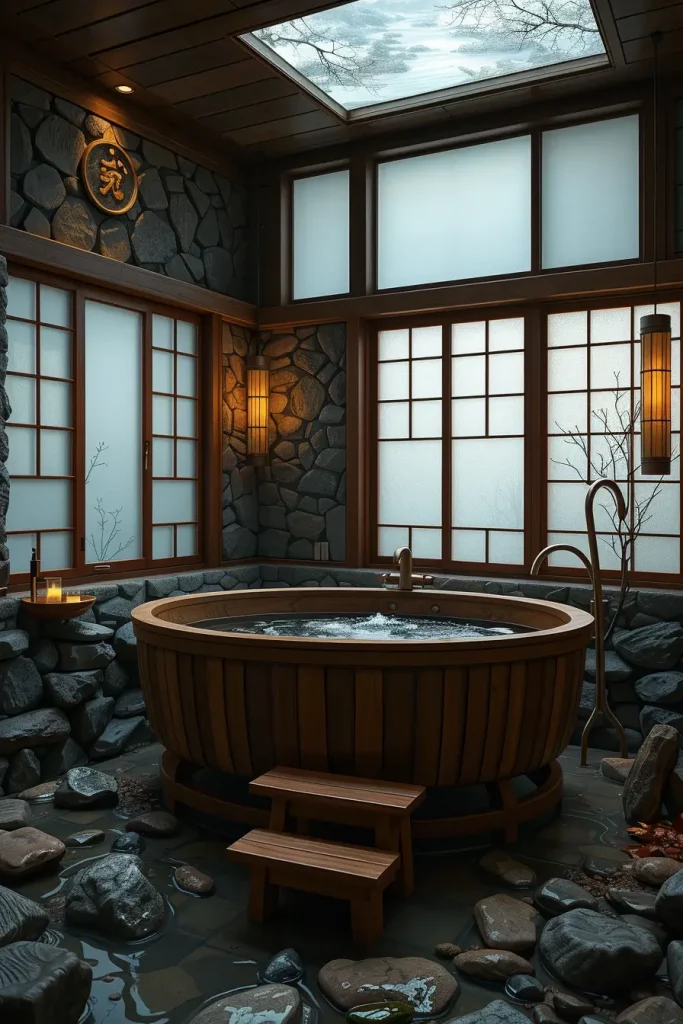
I favor cedar or hinoki tubs placed beside natural stone walls or frosted shoji screens. Built-in seating and a raised platform facilitate easy access. Surrounding the tub with river rocks or sanded tiles and using warm, dim lighting enhances the sensory experience.

This design recalls traditional Japanese onsens, where ritual and relaxation coexist. Elle Decor often emphasizes that incorporating cultural elements enriches a space’s authenticity and charm. For practicality, I recommend adding a discreet handheld shower behind a teak screen, aligning with traditional bathing customs.
Nature-Inspired Organic Tubs: Bringing the Outdoors In
Drawing inspiration from nature, freestanding tubs with organic shapes evoke the tranquility of natural elements-smooth river stones, water droplets, or flower petals. These tubs feature irregular contours and tactile surfaces that feel intuitive and comforting.
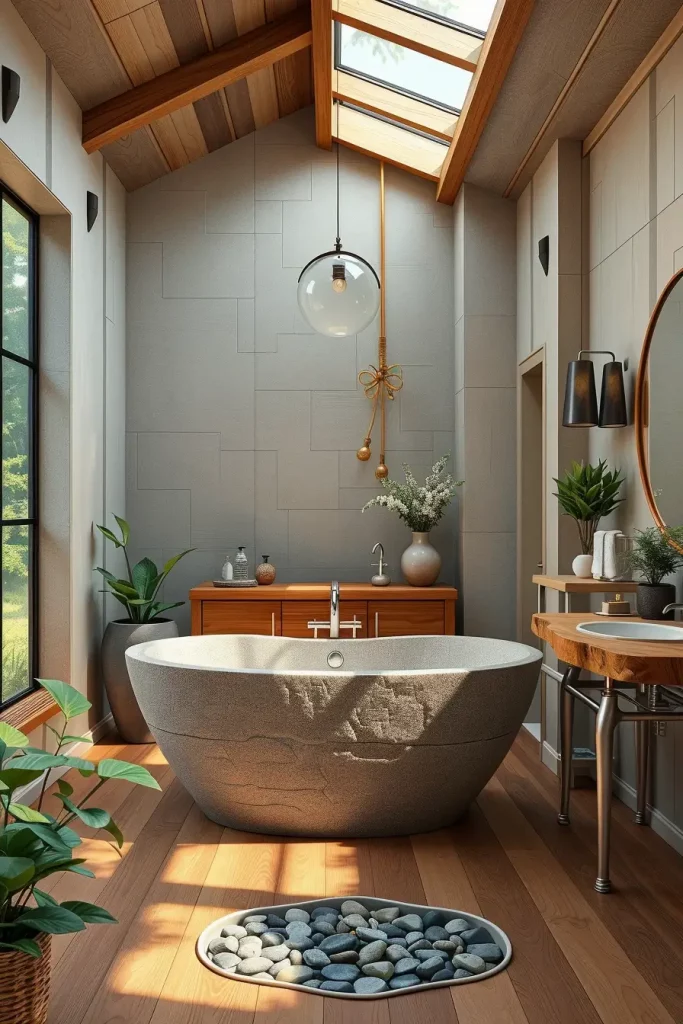
A honey-hued stone composite tub resembling a smoothed river rock pairs beautifully with wood plank flooring, live-edge vanities, and lush greenery like monstera or bamboo. Earth-toned tiles and pebble floors complete the illusion of bathing in a forest spring.
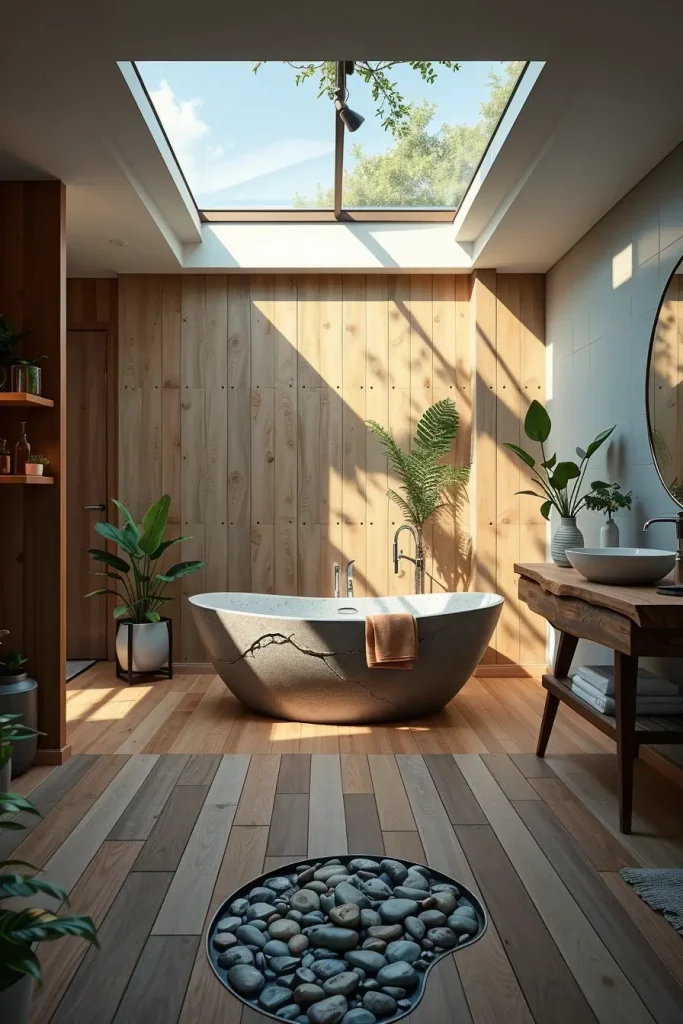
Clients seeking to simplify and reconnect with elemental forms often gravitate toward these designs. This back-to-nature trend, championed by designers like Joanna Gaines, blends rustic charm with modern functionality. Adding a skylight above the tub invites natural light and deepens the immersive experience.
Urban Oasis: Compact Freestanding Tubs for City Living
Even in tight urban spaces, a spa-like bathroom is achievable. Compact freestanding tubs become striking focal points when space is limited, emphasizing verticality and efficient design.

My preferred styles include narrow yet deep oval or slipper tubs made from cast iron or acrylic, ideal for placement near windows or tucked into corners. Storage solutions like floating shelves or built-in niches maximize space. Reflective backsplashes, compact sconces, and chrome fixtures maintain a clean, uncluttered look.
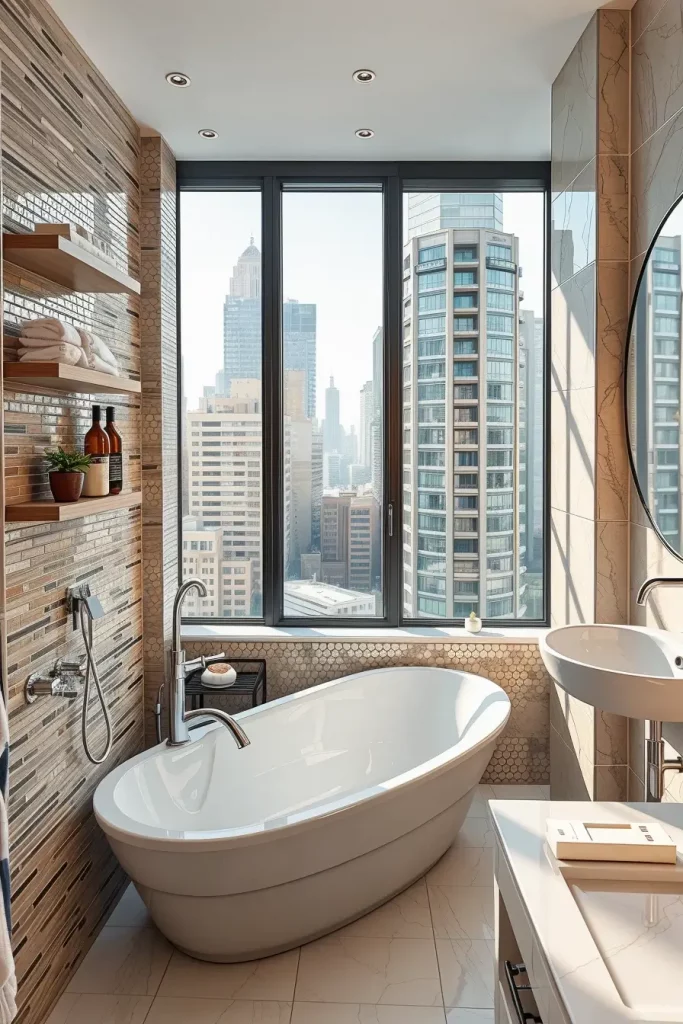
Living in a city myself, I appreciate how thoughtful design can transform limited space into a personal sanctuary. House Beautiful frequently showcases such transformations, proving that size doesn’t dictate comfort or style. Adding sliding pocket doors or translucent partitions can enhance privacy without sacrificing openness.
Luxurious Deep Soak Tubs: Immersive Comfort for Ultimate Relaxation
For those craving full-body immersion, oversized freestanding tubs offer unparalleled luxury. These deep, spacious tubs are perfect for large bathrooms or master suites, providing a resort-like bathing experience.

I recommend cast stone or acrylic tubs at least 70 inches long, deep enough to submerge shoulders comfortably. Features like dual headrests and built-in arm shelves enhance comfort. Surround the tub with tiled platforms, cushioned benches, or chaise lounges to complete the spa vibe.
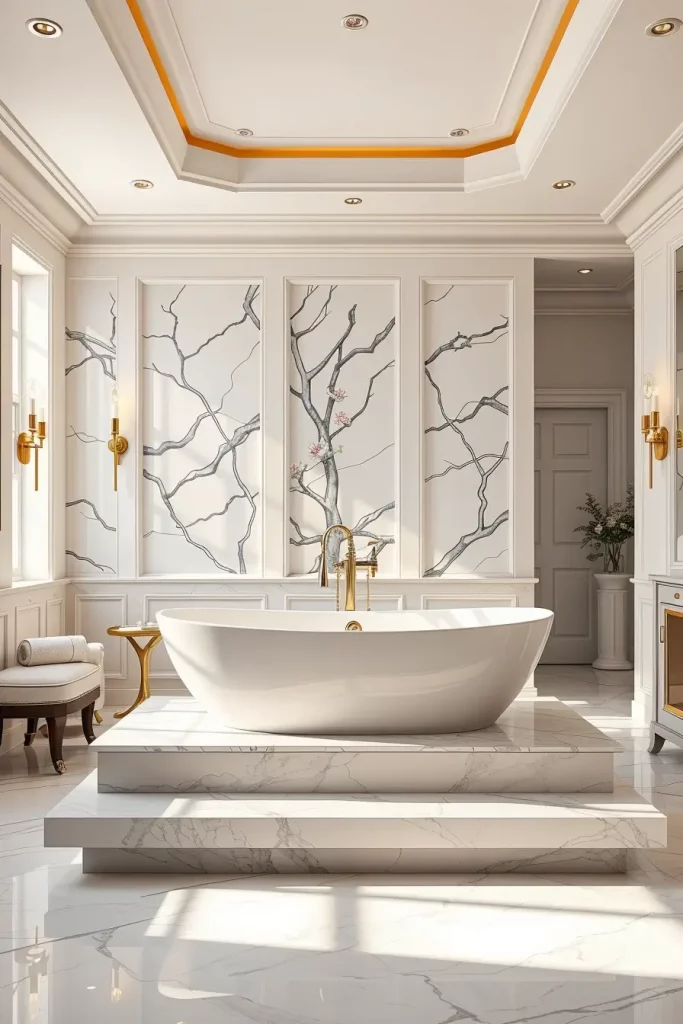
These tubs transform bath time into a five-star resort experience. Designers like Nate Berkus emphasize the power of scale in bathroom elements to create dramatic, inviting spaces. For added indulgence, consider built-in water jets or chromotherapy lighting to introduce hydrotherapy benefits.
Glamorous Metallic Tubs: Brass, Copper, and Gold Accents
To infuse your bathroom with opulence, metallic freestanding tubs are a striking choice. These designs shine in vintage-modern or luxe interiors, where texture and warmth are celebrated.
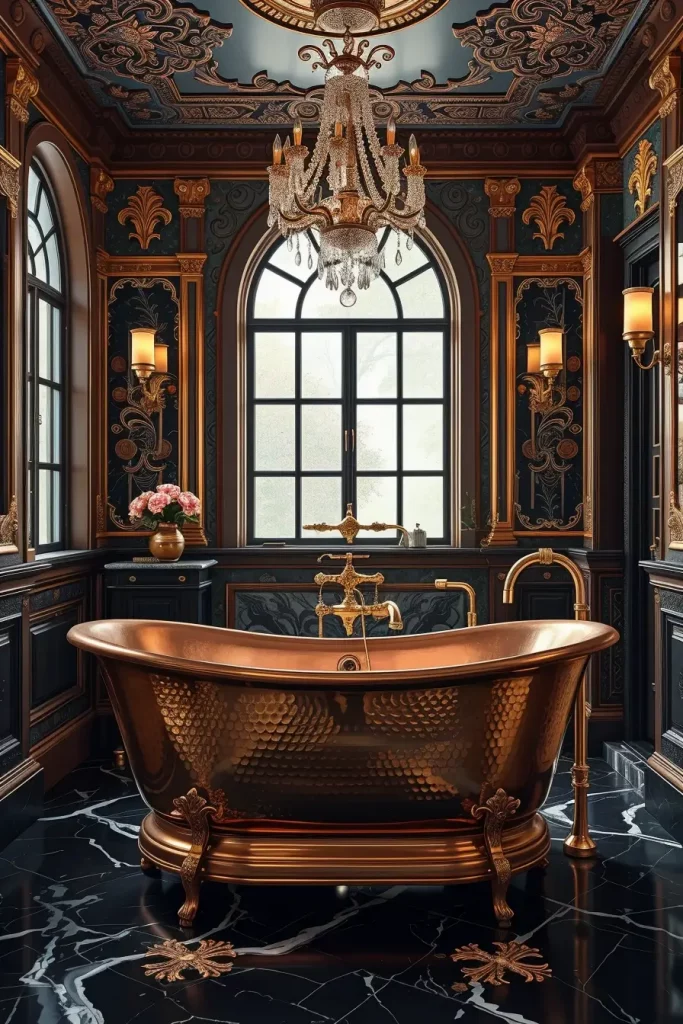
My top pick is a hammered copper tub that develops a natural patina over time. Pair it with black walls, dark marble floors, or jewel-toned tiles for a dramatic effect. Accent lighting such as wall sconces or chandeliers enhances the metal’s gleam.

Gold or bronze tubs exude timeless elegance, often featured in high-end homes and luxury publications like Veranda. To complement the cool metal, I suggest radiant floor heating beneath marble or slate tiles, creating a cozy yet sophisticated atmosphere.
Matte Black Tubs: Bold Statements for Modern Bathrooms
The allure of matte black in bathroom design is undeniable. It introduces a bold, contemporary edge while maintaining a sense of relaxation. Matte black freestanding tubs add depth and drama, especially in predominantly white or monochrome spaces.
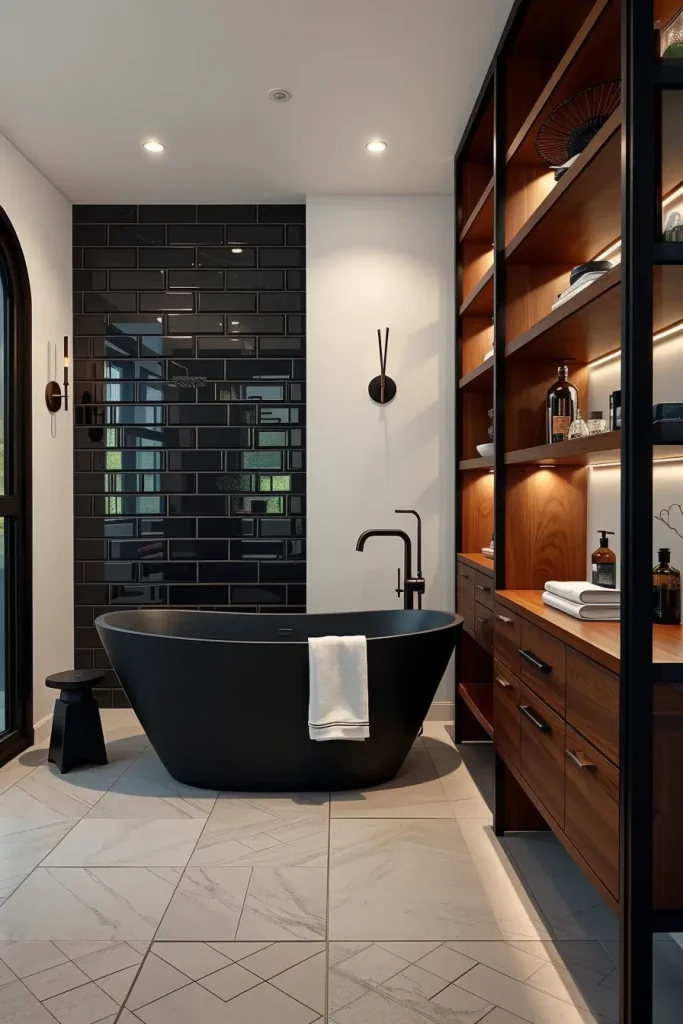
Complement these tubs with black faucets, matte tile backsplashes, and shelving in brushed steel or walnut. Keep decor minimal-white walls, a black vanity, and sparse artwork-to maintain a sleek, focused environment.
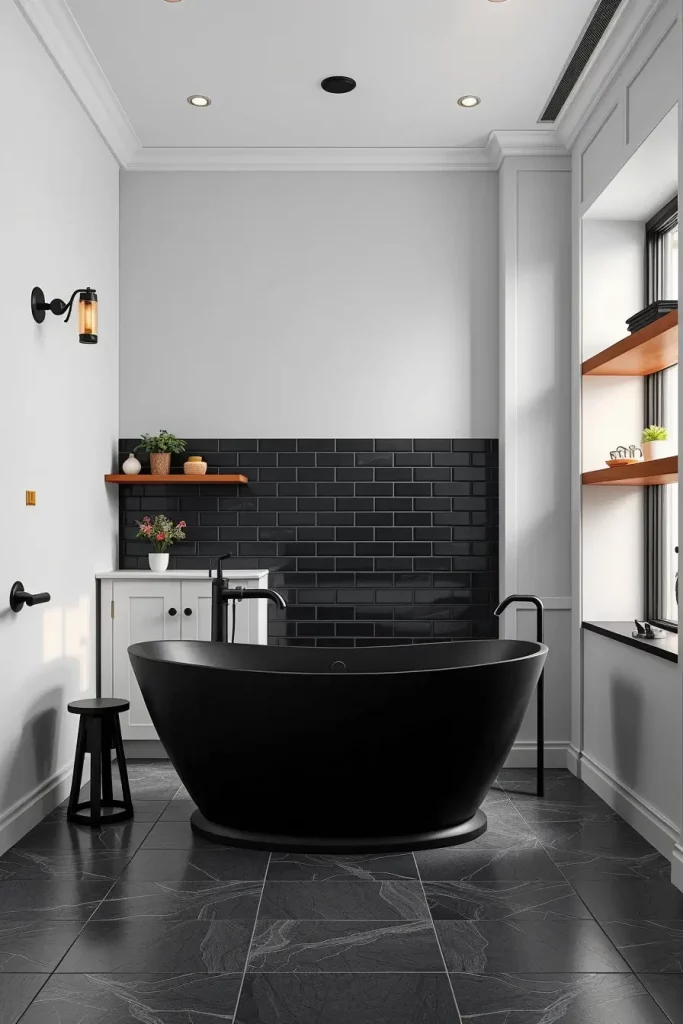
This palette suits urban lofts and dramatic powder rooms alike. Interior Design Magazine notes the rising popularity of matte black finishes for their balance of mystery and strength. For nighttime ambiance, I recommend installing strip lighting beneath cabinets to softly highlight the tub’s silhouette without overwhelming the senses.
Transparent Tubs: The Future of Freestanding Designs
Transparent freestanding tubs are a bold, contemporary choice that embodies openness, purity, and innovation. These glass tubs function as floating sculptures, ideal for light-filled bathrooms.

I prefer tempered glass tubs ergonomically shaped for comfort, placed on marble floors near expansive windows or under skylights. The surrounding space should be pristine, with neutral tones, chrome or glass furnishings, floating benches, and backlit mirrors to emphasize cleanliness.
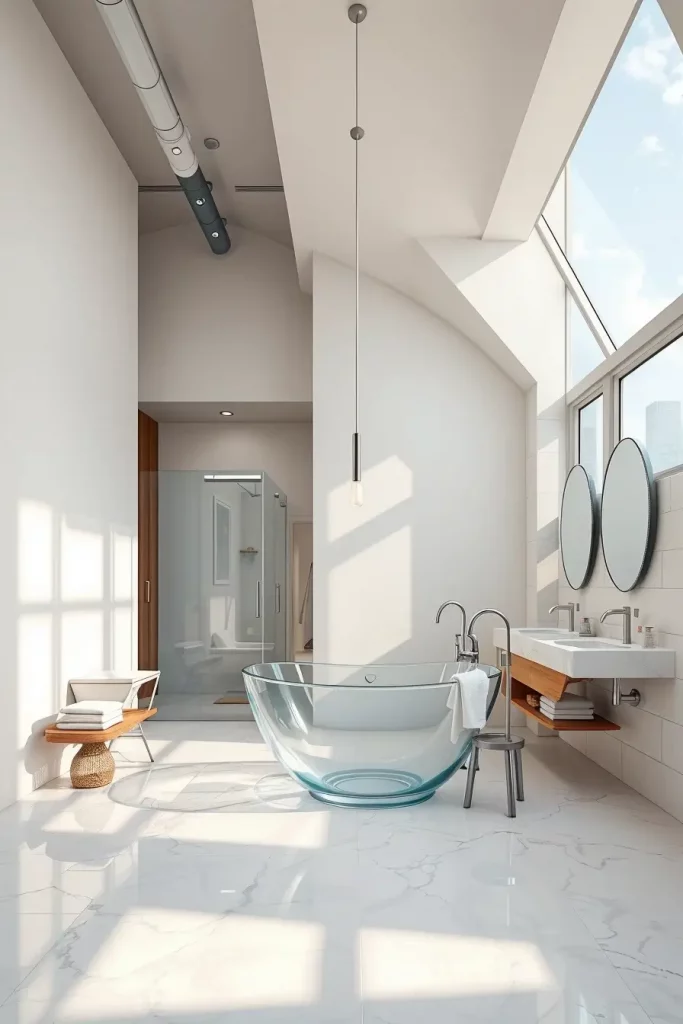
These designs are poised to become the hallmark of spa bathing, transforming spaces by visually expanding them through transparency. Adding recessed LED floor lighting beneath the tub enhances nighttime ambiance, reflecting beautifully through the glass.
Warmth of Wood: Freestanding Tubs with Natural Finishes
Wood has long been a staple in bathroom furniture, and wood-finished freestanding tubs bring warmth and organic beauty to any space. Whether real wood or engineered veneer, these tubs soften cold environments and introduce artisanal charm.
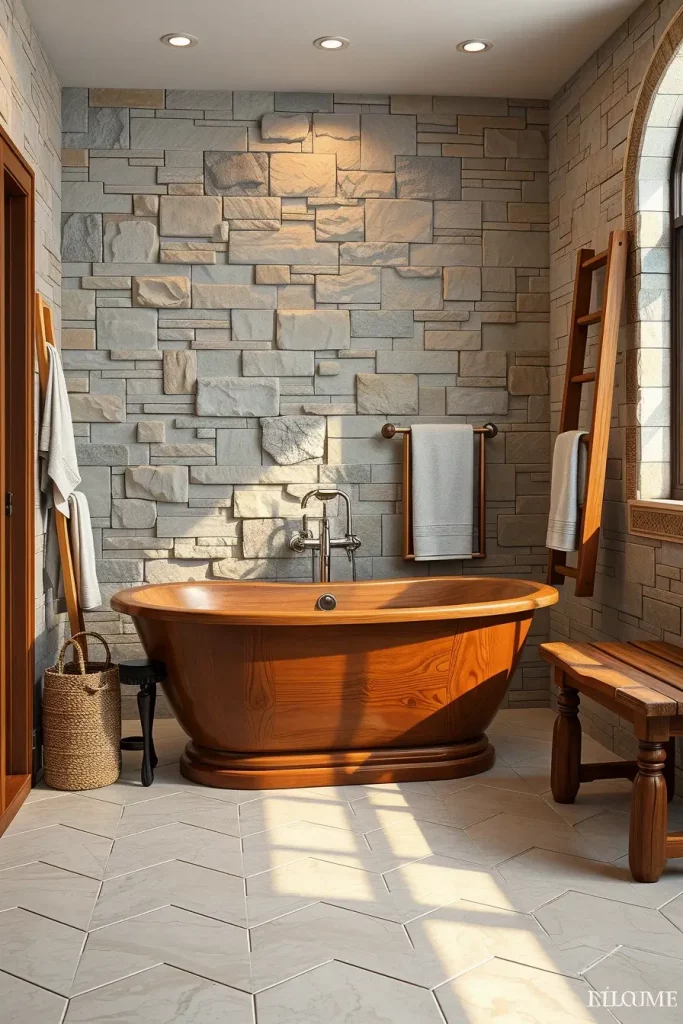
Ideal pairings include travertine floors, stone wall panels, and woven baskets for storage. Position the tub in a well-lit corner with a wooden towel ladder and a reclaimed wood bench nearby. Layered warm lighting-wall sconces, pendant lights, and candles-completes the cozy atmosphere.
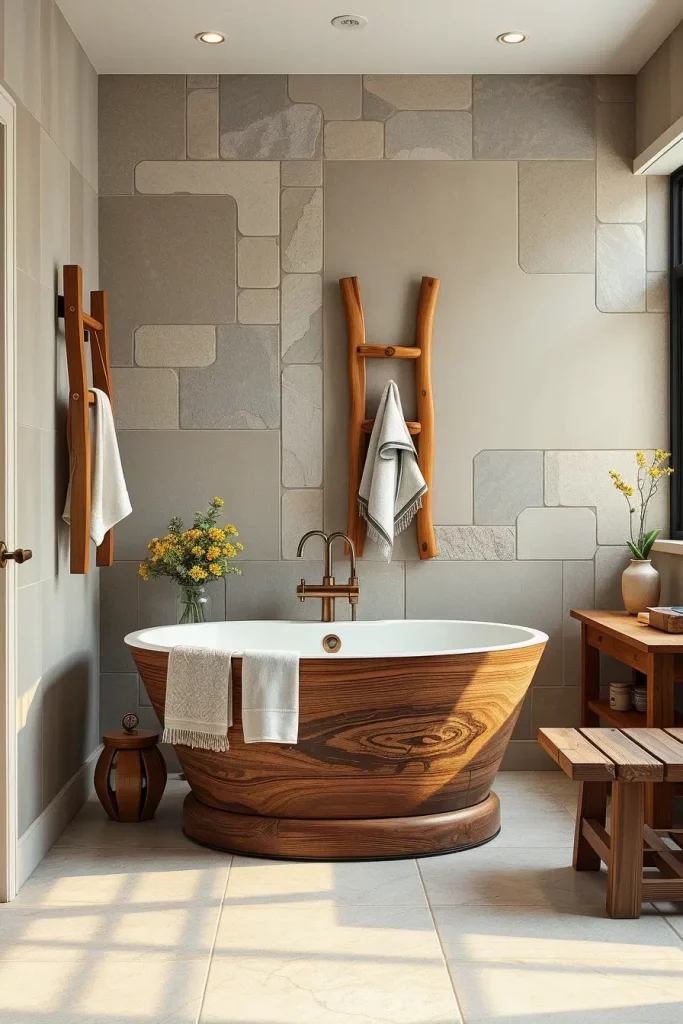
This style evokes Scandinavian-Japanese fusion, celebrated for its calming spirit and craftsmanship. Designers like Sarah Sherman Samuel embrace wood to add comfort to sleek spaces. For a complete natural spa feel, consider radiant floor heating and a slatted wood ceiling.
Industrial Chic: Concrete and Stone Freestanding Tubs
For an urban, industrial vibe, freestanding tubs made from concrete or stone resin offer raw texture and visual heft. These tubs fit perfectly in lofts or converted warehouses where exposed materials are celebrated.
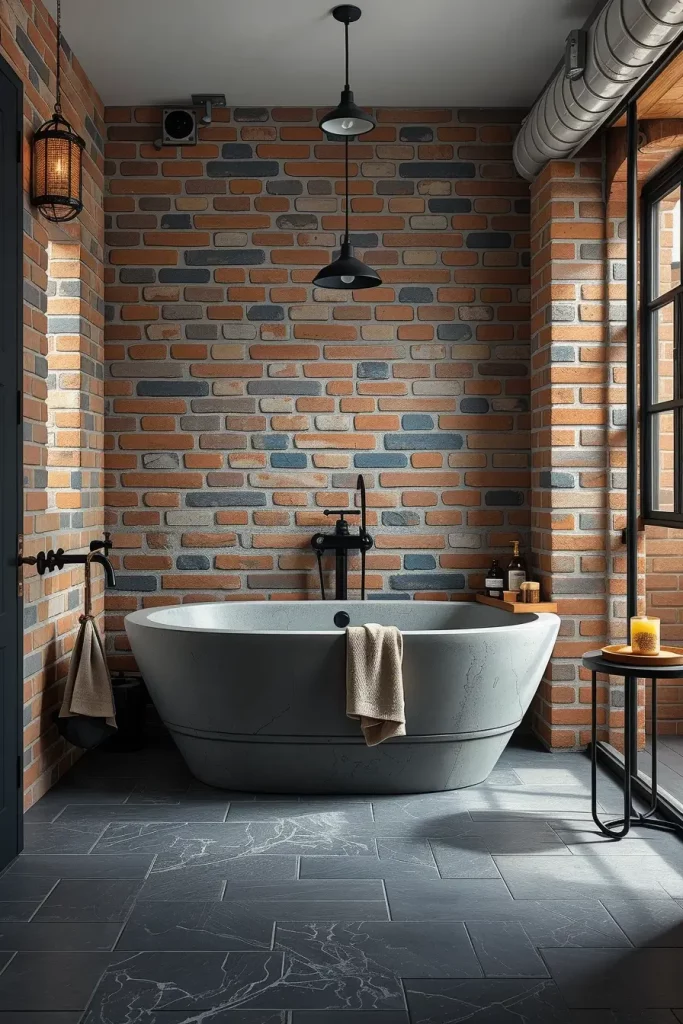
I pair these tubs with matte black faucets, open pipe shelving, and walls finished in dark plaster or exposed brick. Flooring options include smooth concrete or slate tiles, complemented by metal or leather benches to add warmth.
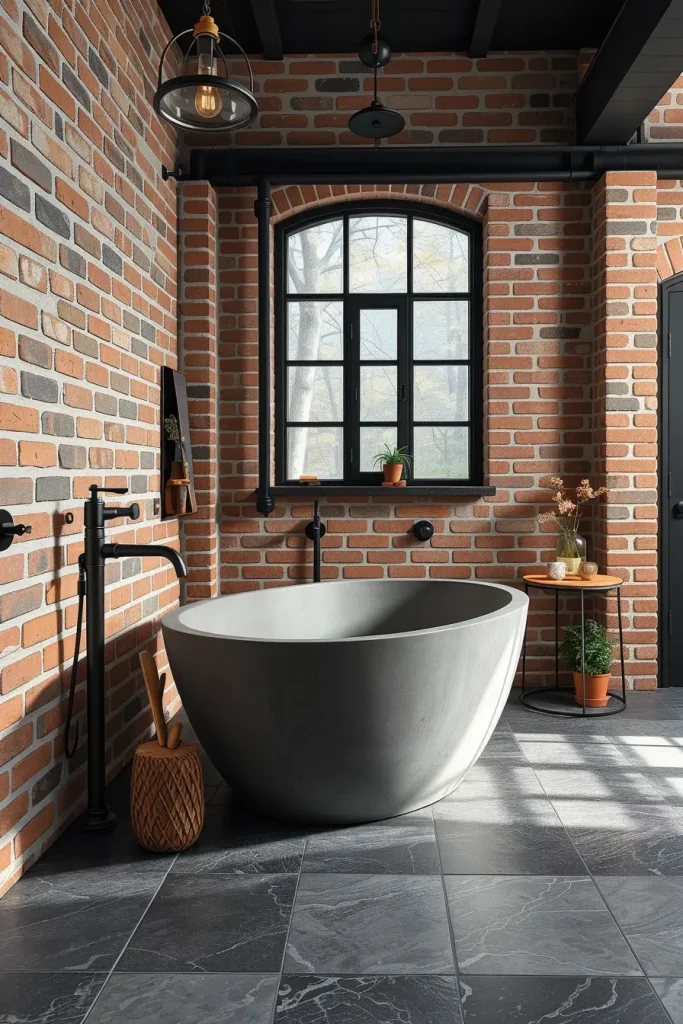
This aesthetic balances rawness with sophistication, echoing the minimalist ethos of designers like John Pawson. Dwell Magazine frequently features such styles in modern home showcases. To soften the coolness, I recommend installing a linear gas fireplace nearby for warmth and ambiance.
Floating Tubs: Creating the Illusion of Weightlessness
One of the most captivating trends is the freestanding tub that appears to float, supported by hidden frames or transparent legs. This design imparts a futuristic, airy vibe that instantly elevates the bathroom’s atmosphere.
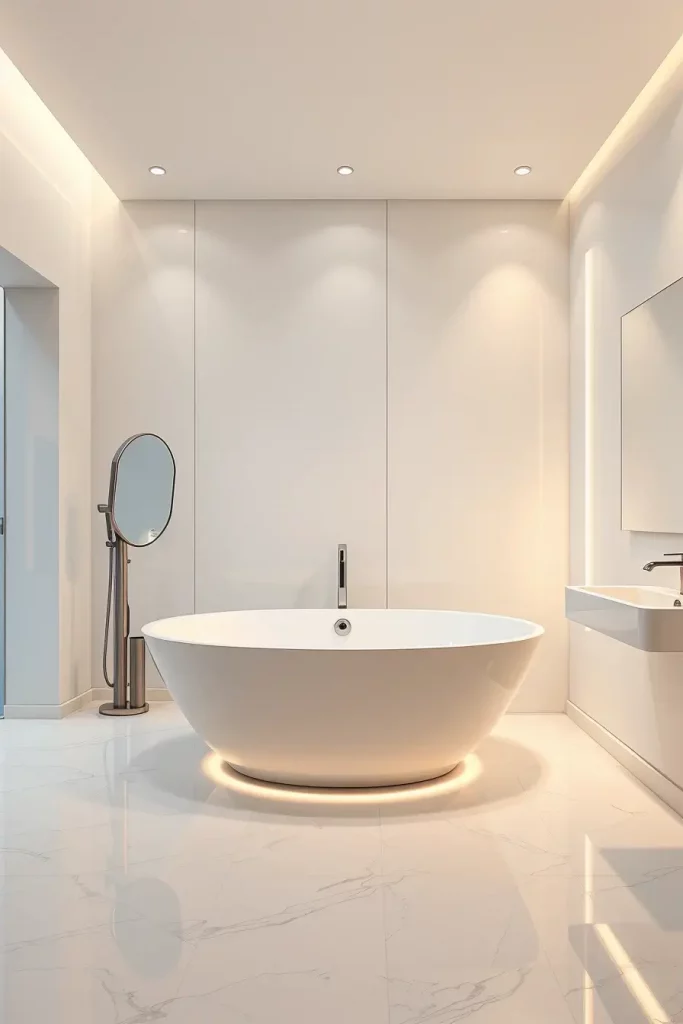
Sleek composite tubs with gentle curves placed on recessed stands or glass supports work best. The surrounding space should be minimalistic-backlit wall panels, neutral floors, and uncluttered surfaces. Lighting is crucial, especially soft LED uplights beneath or behind the tub to enhance the floating effect.
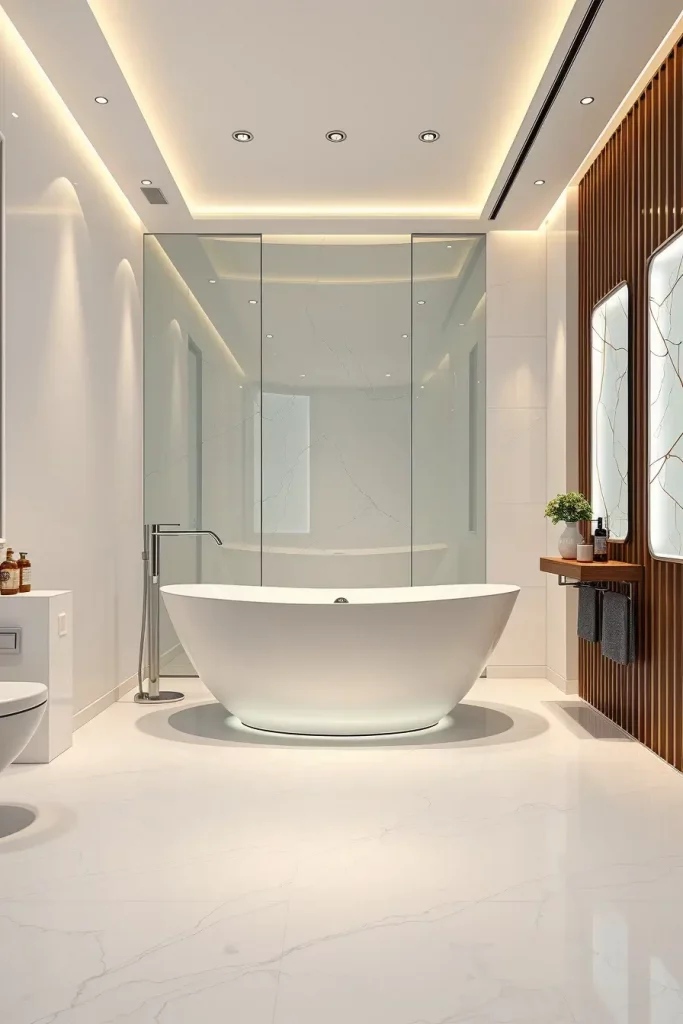
This dreamy aesthetic has been embraced by architects like Philippe Starck and suits minimalist homes seeking a blend of technology and elegance. To complement the illusion, consider frameless glass partitions for showers or sinks, maintaining seamless openness.
Avant-Garde Tub Sculptures: Pushing Bathroom Boundaries
For those who desire a truly conceptual bathroom, avant-garde freestanding tubs offer bold, sculptural forms that defy convention. These installations twist, curve, and challenge traditional shapes, becoming the room’s defining feature.
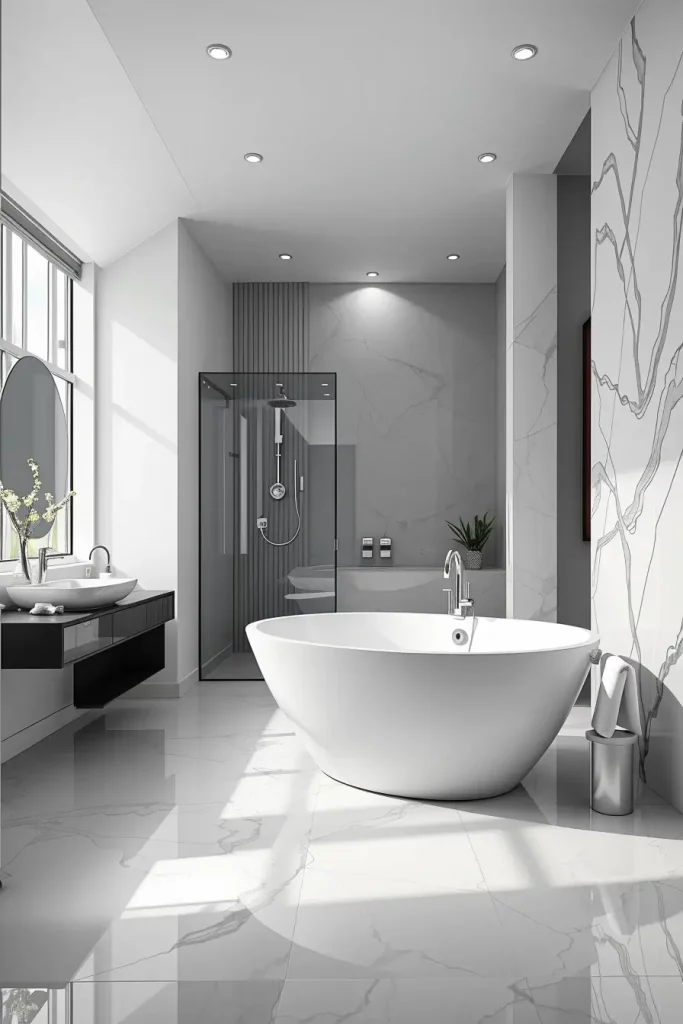
My favorites include abstract resin or high-gloss acrylic tubs shaped like spirals, water droplets, or geometric forms. These designs thrive in open spaces with sculptural lighting, minimal furnishings, and glossy floors that amplify their impact.

Such tubs elevate bathroom design to an art form. I once crafted a tub resembling an inside-out meteor, which clients found uniquely captivating. Luxury hospitality is increasingly embracing avant-garde bathroom elements, as featured in Wallpaper magazine. To complement this artistic vision, consider large-scale paintings or digital art installations behind the tub.
Pure Elegance: White-on-White Tub Designs
For clients seeking clarity and calm, white-on-white bathrooms offer a serene, layered aesthetic. Glossy or matte white freestanding tubs serve as understated showpieces that harmonize with the space.
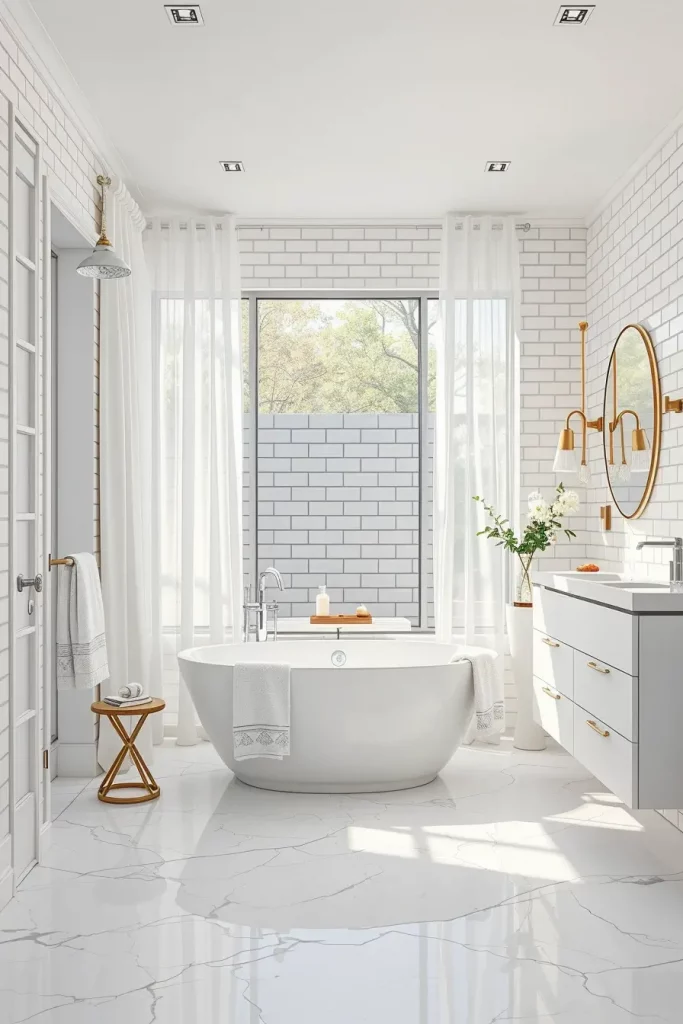
Typically, these tubs are sleek ovals paired with white terrazzo or porcelain floors, subway tile walls, and soft gray or ivory towels. Built-in wall niches hold bath essentials, while sheer curtains soften natural light. Furnishings are minimal-perhaps a floating vanity or lacquered bench.

This look evokes Mediterranean spa resorts, where tonal purity fosters mental clarity. Domino magazine recommends tone-on-tone schemes to maximize perceived space and light in smaller bathrooms. To add depth, consider a large round mirror or sculptural white pendant lighting.
Geometric Tubs: Bold Lines and Modern Masculinity
Geometric freestanding tubs emphasize sharp lines and strong shapes, making a powerful statement in contemporary bathrooms. These designs excel in minimalist settings where the tub acts as the architectural focal point.
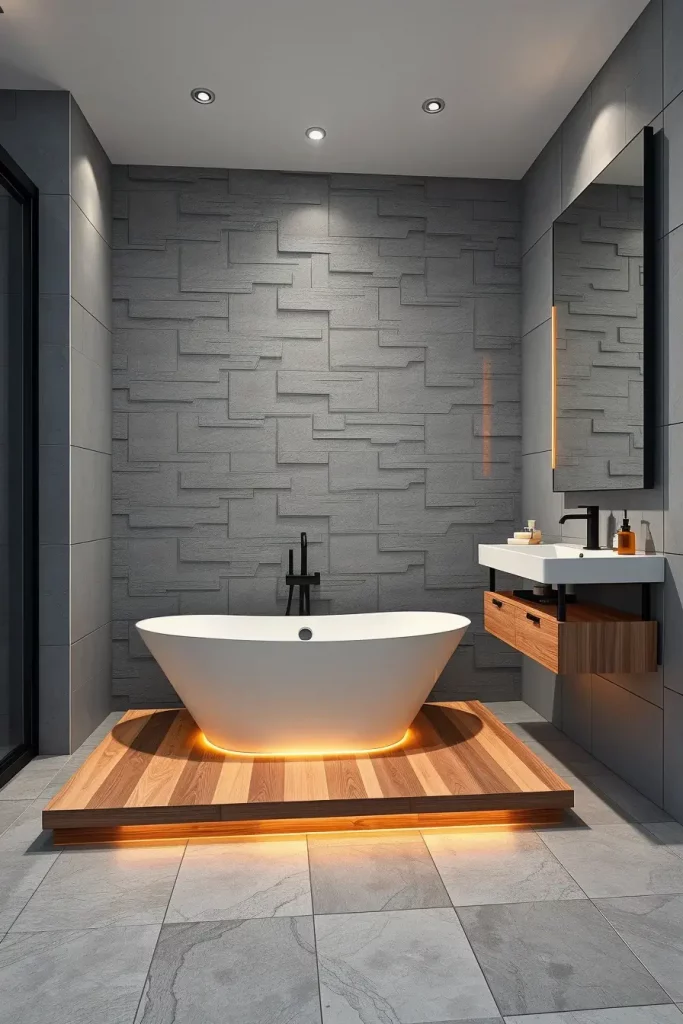
Common shapes include angular, oval, and rectangular tubs with matte finishes in slate gray or soft white, contrasting textured stone walls or glossy cement floors. Surroundings might feature teak platforms, geometric pendant lights, and wall-mounted faucets for a clean, uncluttered look. Oversized mirrors and wall niches reinforce the design’s precision.

Clients who favor simplicity without sacrificing sophistication often choose geometric tubs. Elle Decor recently featured a Los Angeles designer who swears by these shapes for creating impactful bathrooms, even in compact spaces. To enhance this style, add built-in linear LED lighting beneath the tub platform and large square stone tiles to echo the geometric theme.
Retro Revival: Vintage-Inspired Tubs with Contemporary Flair
Blending nostalgia with modernity, retro-inspired freestanding tubs pay homage to mid-century forms, pastel hues, and playful lines. These tubs add character and charm, especially in eclectic interiors where they serve as artistic focal points.
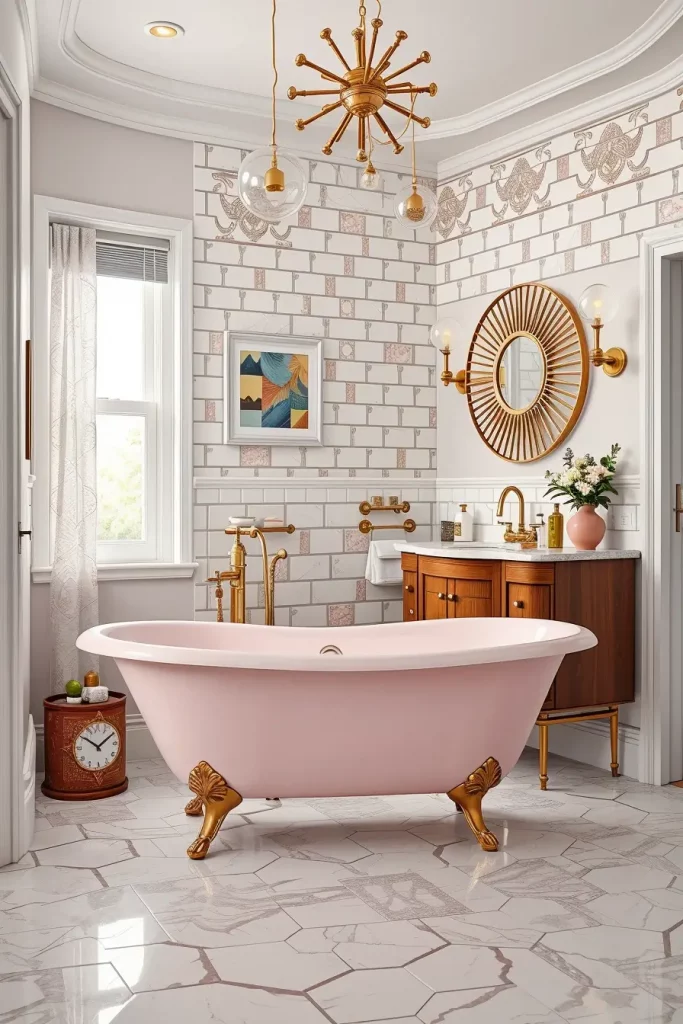
Imagine a powder pink or mint green cast iron tub with slender gold legs, terrazzo flooring, and globe lighting. Walnut vanities with rounded edges and starburst mirrors enhance the nostalgic vibe. Chevron or checkerboard tile patterns provide a perfect foundation.

These tubs are ideal for vintage-modern spaces. Dwell magazine notes that pastel colors in bathrooms evoke emotional comfort, a trend embraced by many clients. To elevate the look, add retro wall art or patterned wallpaper behind the tub, transforming the space into a stylish gallery.
Seamless Nature: Indoor-Outdoor Bathing Experiences
Freestanding tubs that integrate with nature blur the line between indoor tranquility and outdoor beauty. Perfect for homes with large windows, gardens, or warm climates, these tubs create immersive, multisensory bathing experiences.
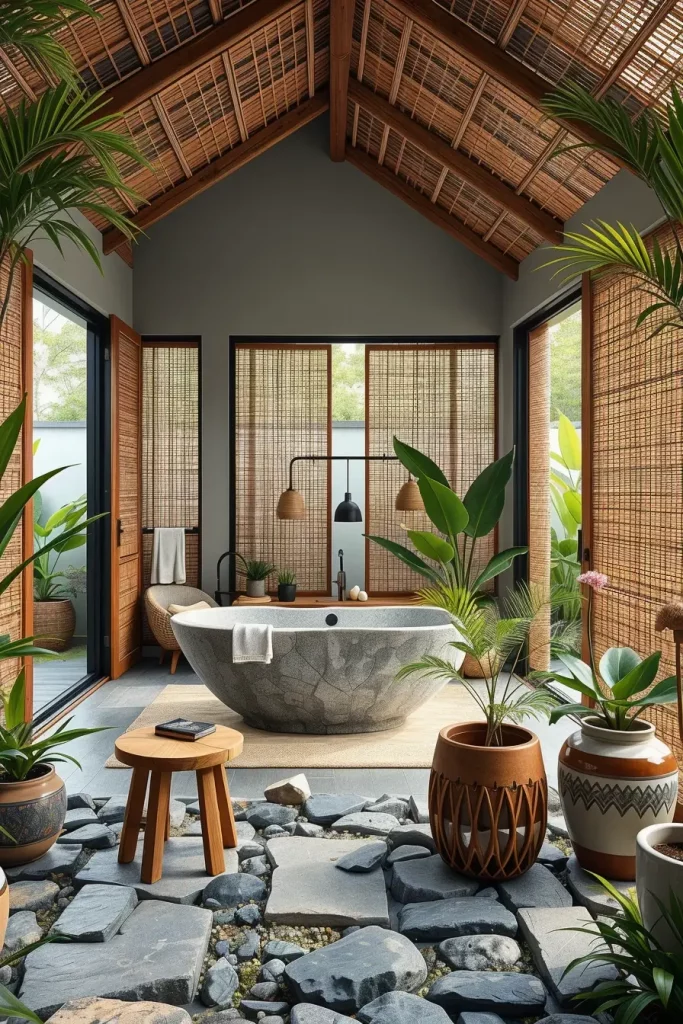
Stone composite or wood tubs placed near bi-fold doors or expansive glass walls work beautifully. Complement with bamboo screens, river rock floors, potted palms, and floating vanities crafted from natural wood. Rain shower heads and skylights enhance the connection to the outdoors.
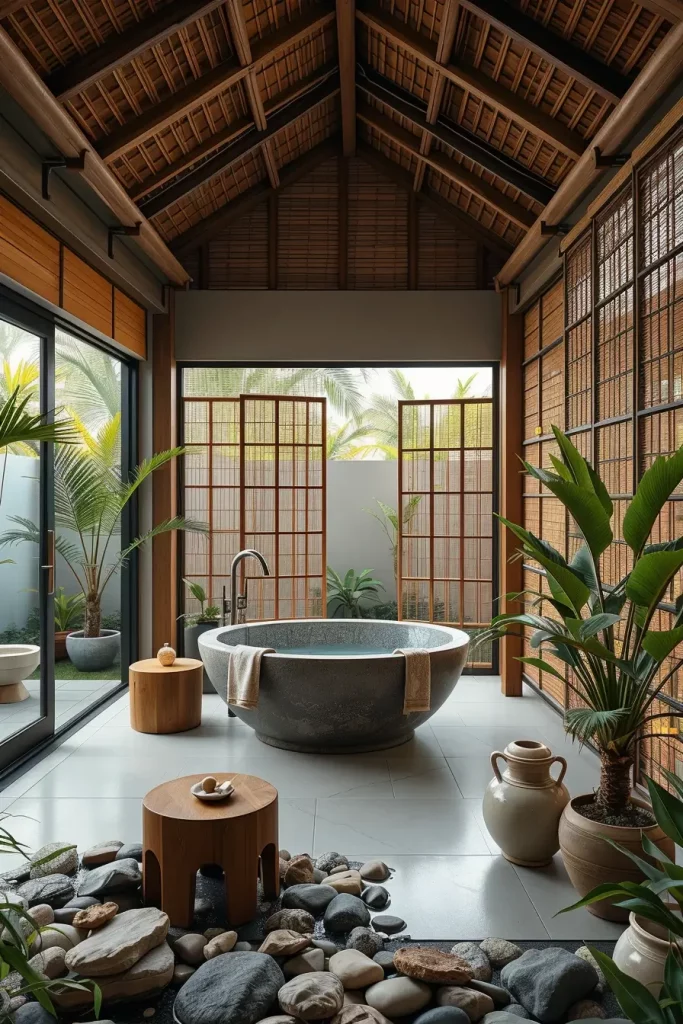
Architectural Digest highlights wellness-focused design as a top trend, and nature-integrated tubs are proven to reduce stress and improve lifestyle. Adding tactile elements like teak stools, handmade ceramic planters, or pebble bath mats warms the space further.
Classic Clawfoot Tubs with a Modern Twist
Traditional clawfoot tubs have found renewed popularity in contemporary homes, especially in transitional spaces blending old-world charm with modern style. Updating finishes or placement can refresh their appeal-think matte black feet instead of chrome or vibrant tub colors against crisp white walls.
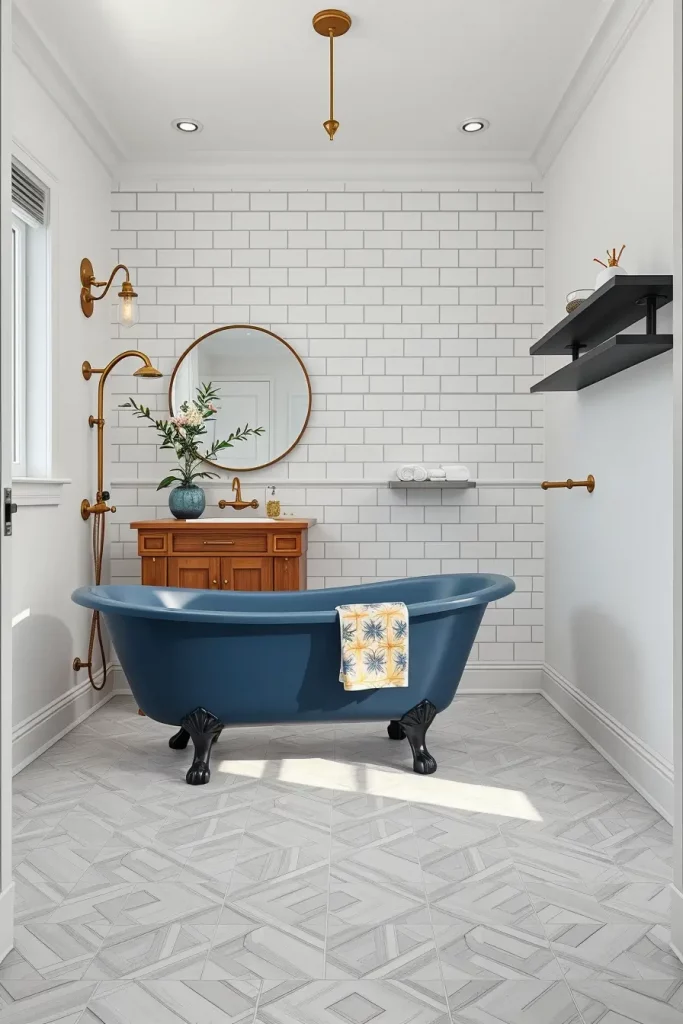
A navy blue clawfoot tub paired with geometric floor tiles, a wooden vanity, and industrial pendant lighting creates a balanced, timeless look. Accessories like glass canisters and brushed brass taps complete the ensemble without overwhelming it.
Interior designer Emily Henderson champions layering historical elements to add depth, a strategy I encourage for clients seeking soulful yet contemporary spaces. To enhance this style, consider a matte black floating shelf to complement the tub’s feet or a modern art print above the tub.
Couples’ Retreat: Two-Person Freestanding Tubs
Designed for shared relaxation, two-person freestanding tubs offer ample space and comfort, making them a staple in upscale home spas. These tubs are wider, deeper, and perfect for master bathrooms where romance and utility coexist.
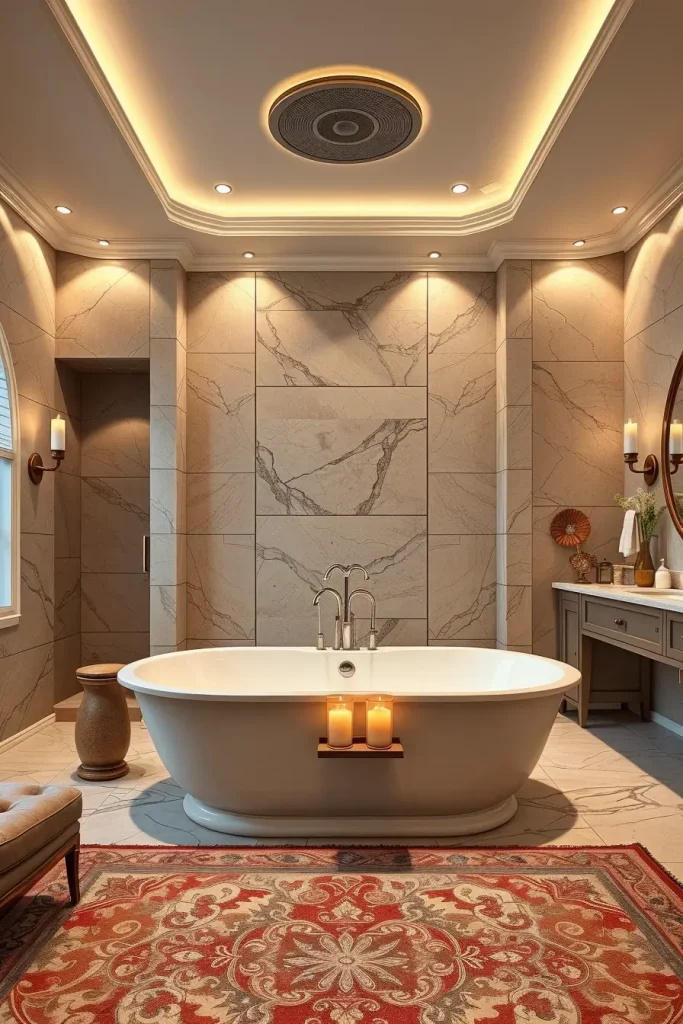
Ideal designs feature dual slanted backs or side-by-side seating, with generous ledges for candles and drinks. Surround with warm materials like travertine tiles, backlit mirrors, and dimmable ambient lighting. Large floor rugs and double vanities balance the room’s scale.

According to a 2024 Houzz trend report, self-care features like these tubs are increasingly sought after. To enhance the spa atmosphere, I suggest integrating Bluetooth-enabled sound systems within walls or ceilings for immersive audio experiences.
Space-Savvy Elegance: Small Freestanding Tubs
Limited bathroom space doesn’t mean compromising on style or comfort. Compact freestanding tubs, such as oval or Japanese soaking designs, maximize depth while minimizing footprint-ideal for urban apartments or secondary bathrooms.

In a recent project, I installed a high-walled oval tub near a window, surrounded by vertical subway tiles and floating shelves to conserve floor space. A small pendant light and towel warmer added function without crowding. Neutral tones keep the space airy and elegant.

The Spruce recently highlighted the rise of micro-luxury bathroom makeovers, proving that small-scale designs can deliver big impact. To optimize functionality, I recommend built-in niches for bath essentials and mirrored cabinets to enhance storage and create a sense of spaciousness.
Ambiance Amplified: Freestanding Tubs with Integrated LED Lighting
Lighting profoundly influences the bathing experience. Freestanding tubs with built-in LED features offer customizable ambiance, shifting from energizing to calming moods-perfect for modern or futuristic bathrooms.

Examples include tubs with illuminated bases, under-glow panels, or lighted headrests. I design lighting controls to adjust color temperature and hue, pairing these tubs with glossy tiles, chrome fixtures, and minimal cabinetry to spotlight the illumination.

Clients appreciate the ability to control lighting with ease. Forbes recently featured LED baths as a premier wellness innovation in luxury homes. For added convenience, I suggest motion-sensor strip lighting around the tub perimeter paired with a dimmable smart control panel for effortless evening use.
Elevated Luxury: Freestanding Tubs on Raised Platforms
Installing freestanding tubs on raised platforms adds a sense of ceremony and grandeur, making the tub a captivating focal point in spacious bathrooms.
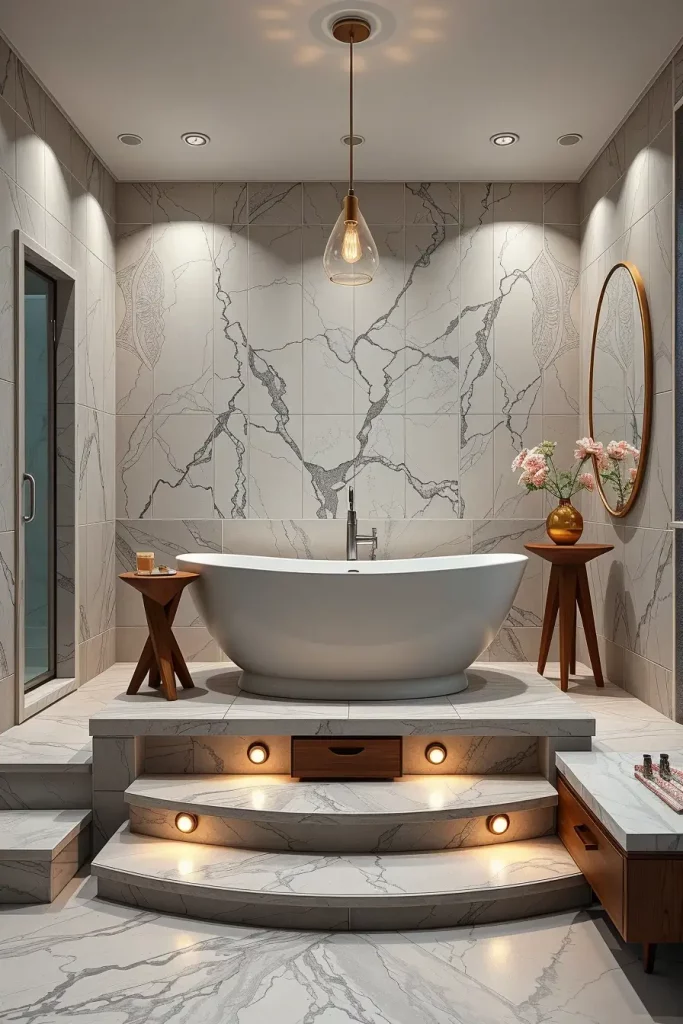
I often use stone or engineered wood platforms that complement the tub’s smooth finish and base texture. Built-in step lights, sculptural side tables, and decorative wall treatments complete the luxurious ambiance. Symmetry is enhanced with large marble tiles and pendant lighting above the tub.

Clients report that raised tubs consistently elevate their bathing experience. Architectural Digest notes the resurgence of raised tubs as centerpieces in lavish renovations. To maximize utility, I recommend integrating hidden drawers beneath the platform for storing towels and bath essentials.
Smart and Functional: Freestanding Tubs with Storage and Technology
Combining beauty with practicality excites me, especially when freestanding tubs incorporate built-in storage or smart features. These models suit modern lifestyles where convenience is as vital as aesthetics.
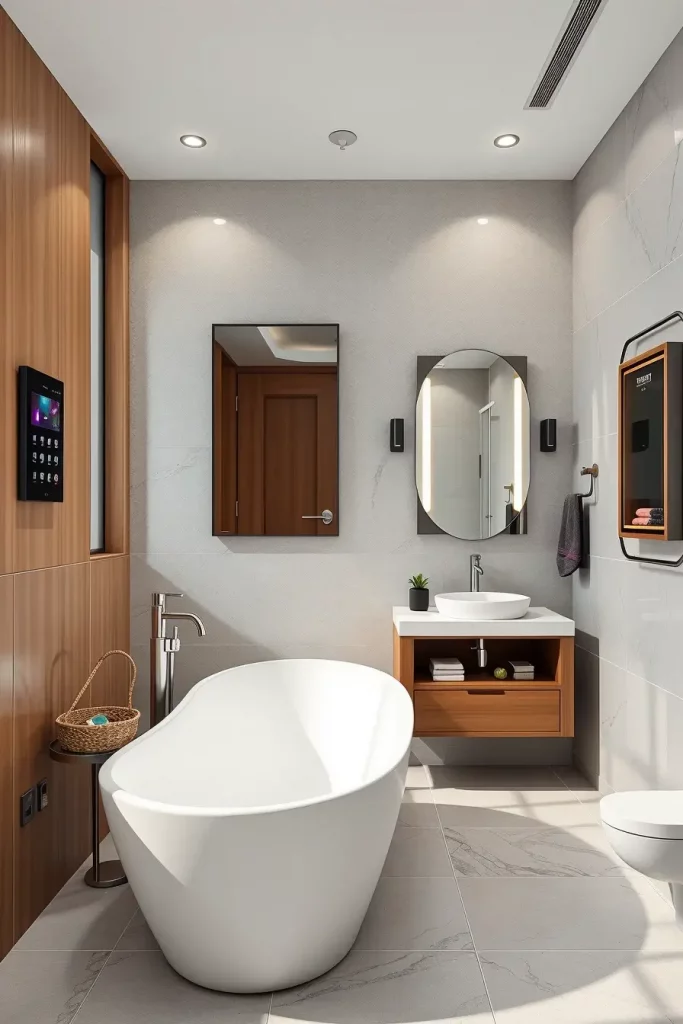
One favorite design includes recessed shelving on the tub’s exterior for bath oils, candles, or waterproof reading materials. More advanced tubs feature pre-set temperature controls, voice activation, and integrated sound systems. These pair well with floating vanities, smart mirrors, and clean lines.

Clients appreciate how these innovations enhance both form and function. Houzz’s 2024 report confirms smart technology is now essential in upscale bathroom renovations. To streamline control, I suggest pairing the tub with a wall-mounted tablet or touchscreen for seamless management of digital features.
Spa-Quality Tubs: Aromatherapy and Hydrotherapy Integration
For unparalleled relaxation, spa-inspired tubs equipped with aromatherapy and hydrotherapy features transform your bathroom into a personal wellness retreat.
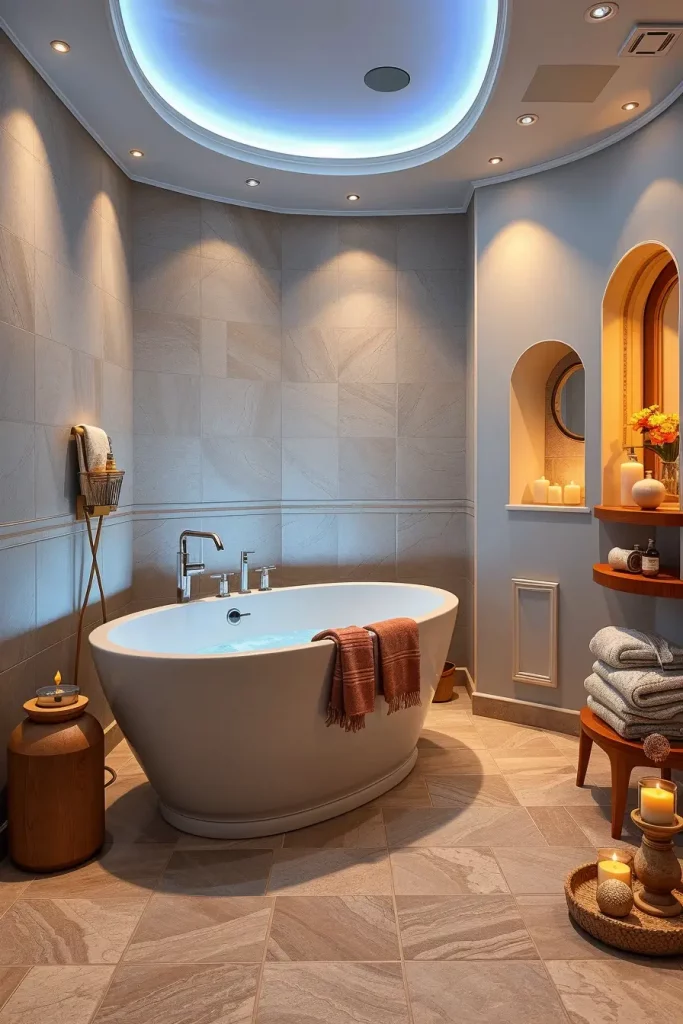
Top-tier spa tubs include air jets, chromotherapy lighting, and scent diffusers built into the shell. I place these tubs in neutral-toned spaces accented with natural materials like limestone and cedar. Adding towel warmers, soft lighting, and incense candles completes the sanctuary.
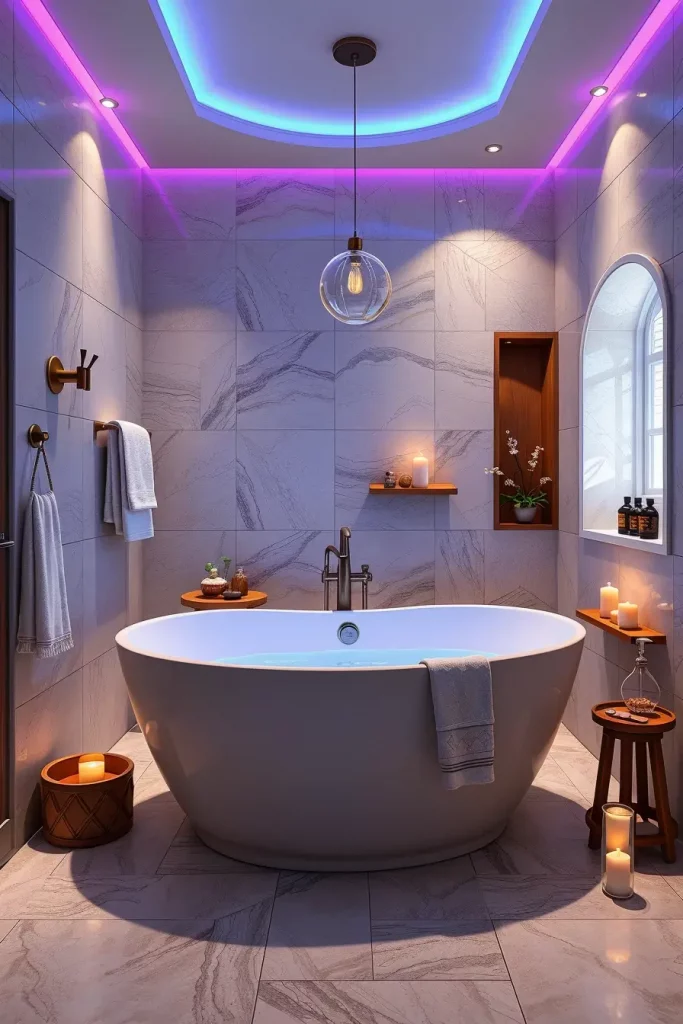
These tubs represent a breakthrough in everyday self-care. Veranda magazine highlights therapeutic bathing as a leading wellness trend among discerning homeowners. To enhance this setup, consider adding an aromatherapy dispenser and a towel drawer or built-in herbal rack stocked with eucalyptus or lavender.
Custom Tile Surrounds: Framing Your Tub with Style
Custom tile surrounds can transform a freestanding tub into an integrated work of art. I recommend this approach when the tub is placed near a feature wall or architectural niche, adding texture, symmetry, and depth.

Mosaic tiles, chevron marble walls, or matte porcelain tiles halfway up the wall create stunning backdrops. Pair with simple white or black tubs and bare metallic faucets. Matching tiled platforms or wainscoting unify the design.
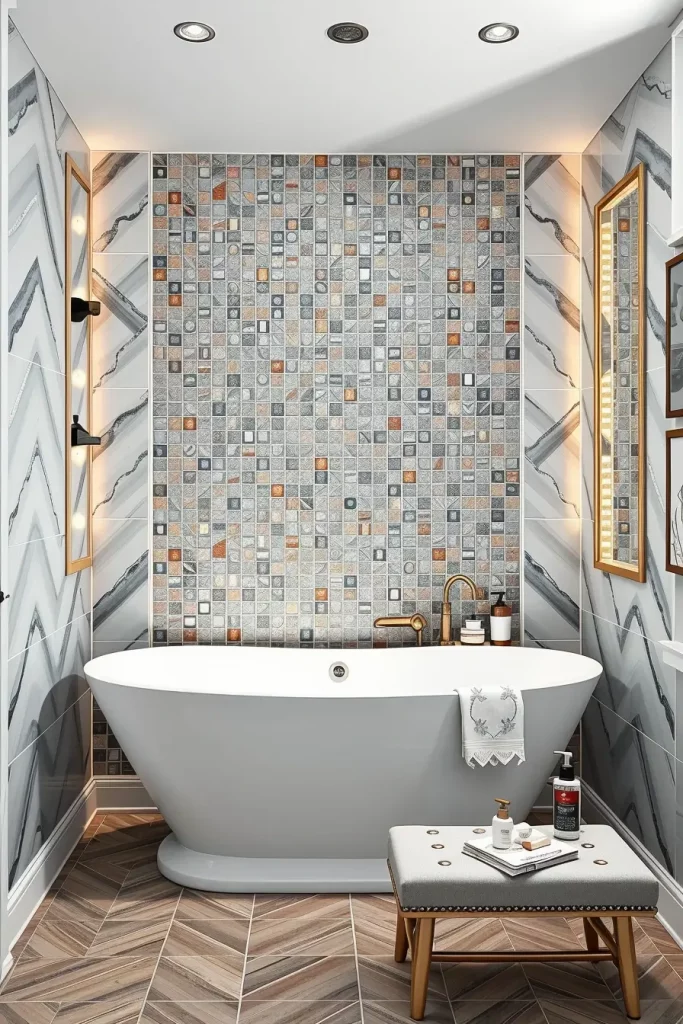
This layered style adds distinction without overwhelming the space. Domino Magazine named tile framing a top visual trick for bathroom upgrades in 2025. To complete the look, install recessed LED lighting along tile edges or add a tiled bench for bath essentials.
Floor-Mounted Faucets: Dramatic Complements to Freestanding Tubs
Few combinations rival the elegance of a freestanding tub paired with a striking floor-mounted faucet. This duo creates visual poetry, especially against minimalist backdrops.

I often select matte black or brushed gold faucets with flowing lines that echo the tub’s shape. Positioned against neutral walls or large stone tiles, they become focal points. Adding a small side table and a basket of rolled towels enhances the spa feel.

Clients consistently praise the drama this setup brings. House Beautiful recently ranked floor-mounted fixtures among the most requested in bathroom remodels. For added comfort, place a decorative rug beneath the tub and faucet to define the area and soften the floor.
Open-Plan Bathrooms: Showcasing Freestanding Tubs
Open-concept bathrooms are increasingly popular, emphasizing flow and natural light. Freestanding tubs become stunning focal points in these spaces but require thoughtful design to balance openness with intimacy.

I often position tubs adjacent to frosted glass walls or within niches that connect visually to adjoining spaces. Materials like polished concrete floors, translucent curtains, and dual-sided fireplaces create a blend of privacy and luxury. Statement lighting anchors the tub within the larger room.
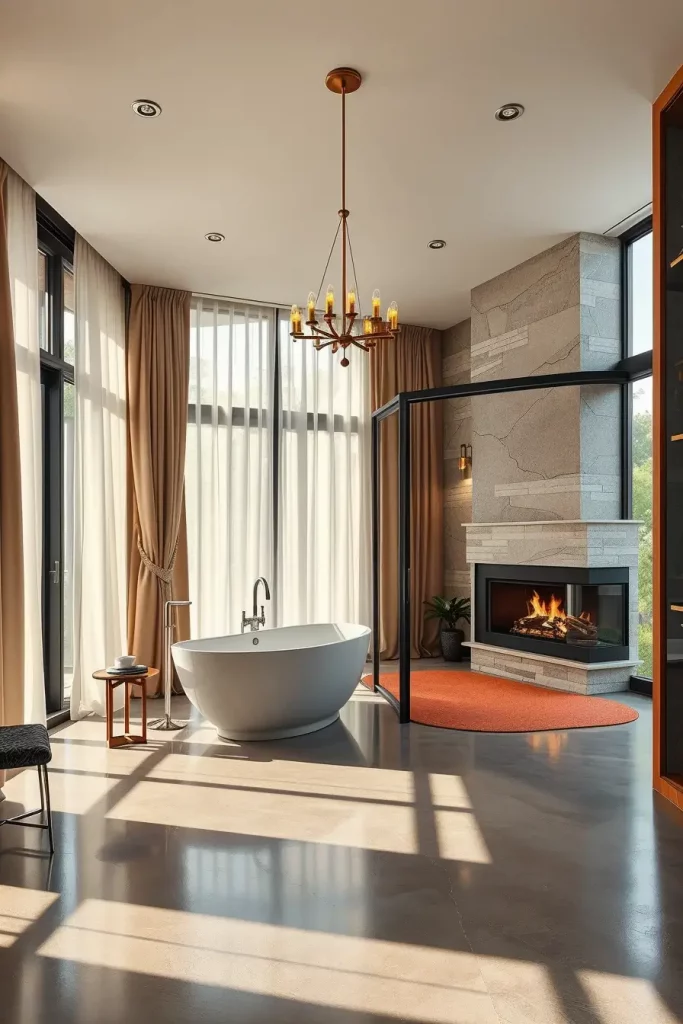
Open-plan bathrooms thrive in lofts and contemporary homes. Elle Decor notes that lovers of transparency and fluidity favor this layout. When designing, I emphasize smart zoning and moisture control. To maintain openness while offering privacy, I recommend retractable glass screens or delicate partitions.
Colorful Tubs: Infusing Personality and Vibrancy
While white tubs remain timeless, colored freestanding tubs make bold personality statements. Jewel tones like emerald and sapphire, pastels, and deep hues such as matte black or navy enliven neutral bathrooms.

One favorite is a forest green enamel tub with brass fittings, white wall paneling, and herringbone floors. Complement with curated wall art and towels that echo the color theme. The key is restraint-the tub should remain the star, with other elements supporting the mood.
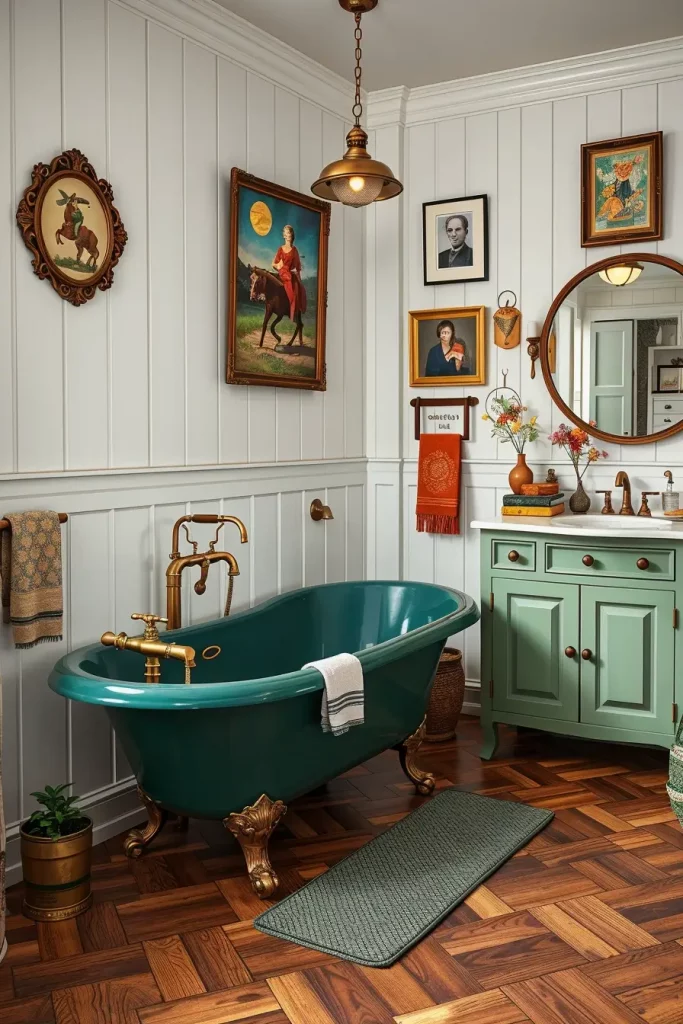
After over a decade of experimenting with color, I’ve found clients consistently love adding hues to their bathrooms. Better Homes & Gardens predicts colored tubs will trend in 2025 as a form of self-expression. To unify the look, consider a built-in bench or painted vanity matching the tub’s color.
Glass-Enclosed Tub Spaces: Showcasing the Tub as Art
Freestanding tubs surrounded by glass walls create dramatic, sculptural spaces. This design enhances natural light and spatial perception, perfect for large bathrooms where architectural lines and light interplay are key.
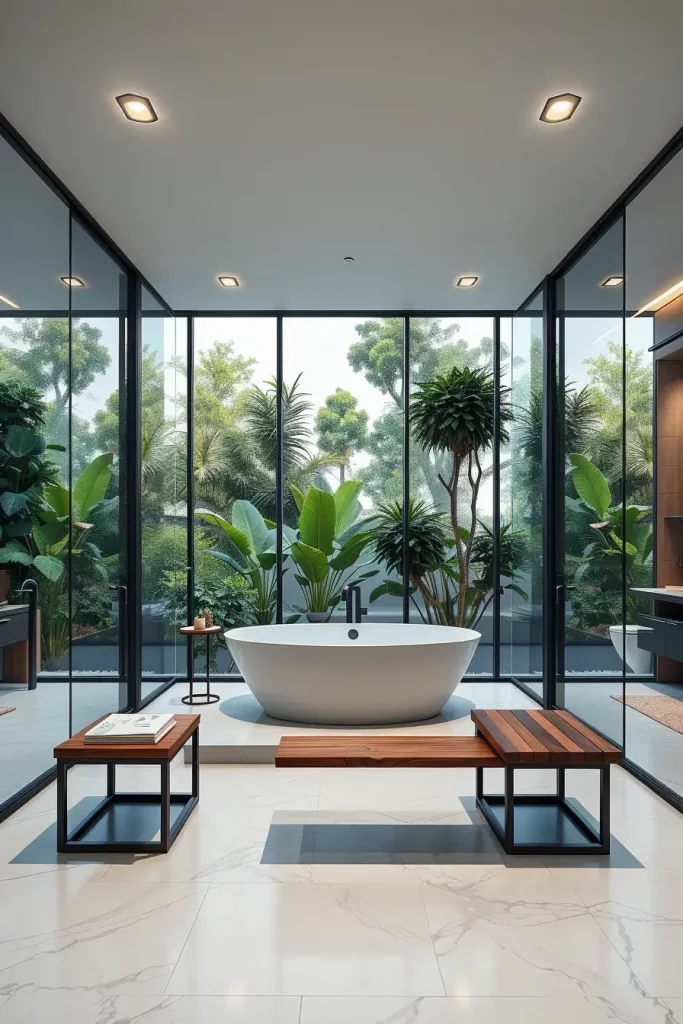
Typically, these rooms feature floor-to-ceiling windows, marble or porcelain floors, and acrylic or stone tubs on pedestals. Furnishings are minimal-wood-velvet stools, teak benches, recessed towel shelves, and matte charcoal fixtures. Adjustable lighting over the tub creates a showroom-quality oasis.
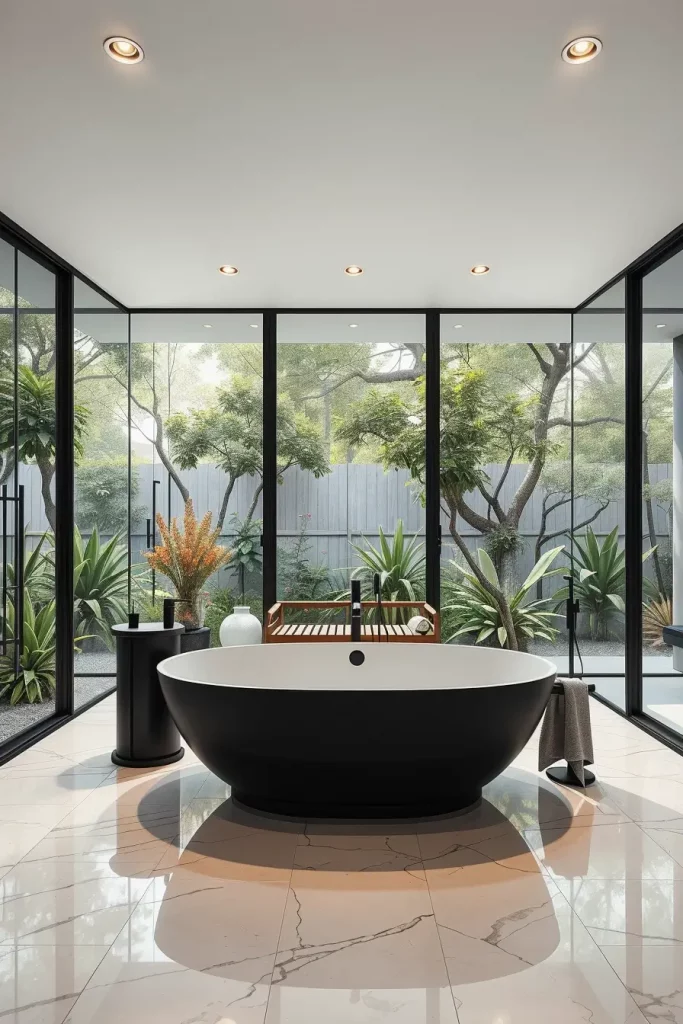
This setup suits city lofts and modern homes. Architectural Digest and Elle Decor praise it for transforming ordinary bathrooms into designer retreats. For privacy, consider etched or frosted glass designs or large indoor plants. Tech-savvy homeowners might enjoy flat-screen mirrors or embedded media screens.
Zen Corners: Compact Freestanding Tubs for Small Bathrooms
Transforming small bathroom corners into tranquil retreats is achievable with Zen-inspired freestanding tubs. This approach maximizes limited space while fostering calm and minimalism.
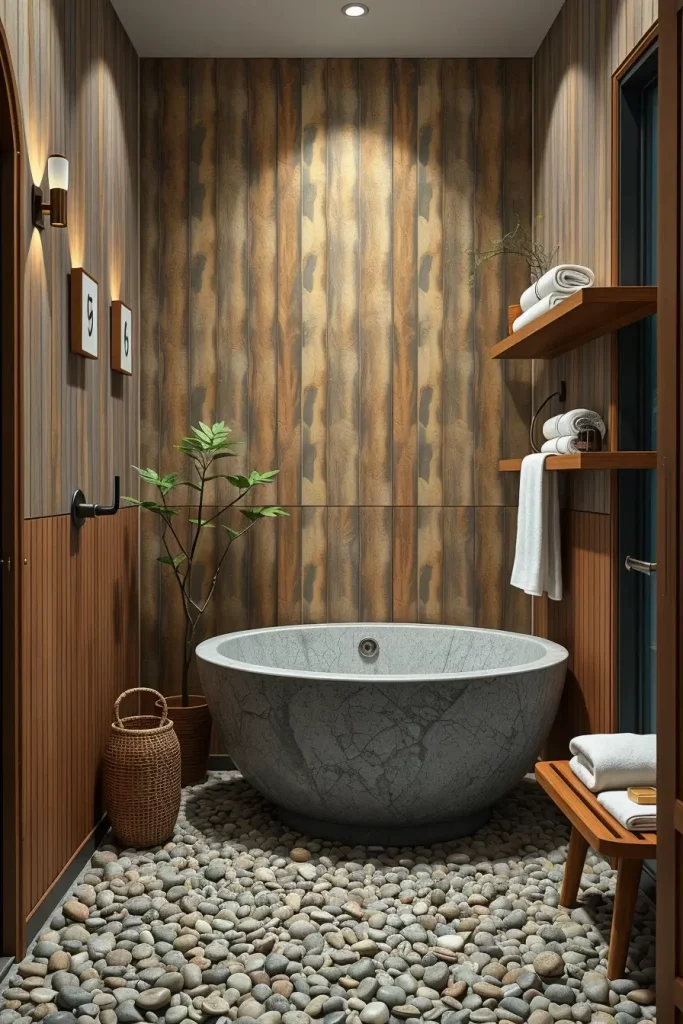
Ideal tubs are small oval or round clawfoot models made from stone resin or matte acrylic, framed by natural wood slats or bamboo panels. Pair with pebble flooring or large neutral tiles. Surround with low-profile teak shelves, rolled white towels, and plants like bonsai or peace lilies. Soft wall sconces or concealed LED strips provide gentle lighting.
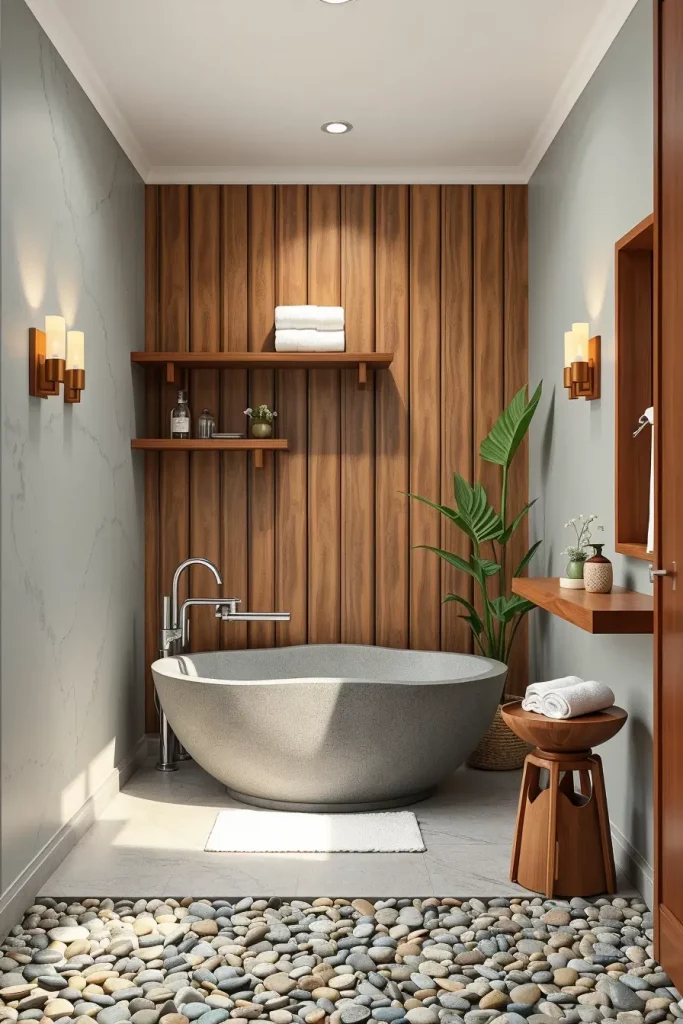
I’ve applied this design in condos and guest baths where space is tight but luxury is essential. Dwell Magazine highlights corner tubs as a rising trend for small spaces. I advise clients to add niches for essential oils or bath salts and overhead rain showers to create hybrid zones. Built-in aromatherapy diffusers further enhance the spa experience.
Marble Marvels: Statement Tubs with Natural Elegance
Carved marble freestanding tubs make bold, luxurious statements in bathrooms. Each tub’s unique veining adds character, making them ideal anchors for grand master suites or upscale spas.
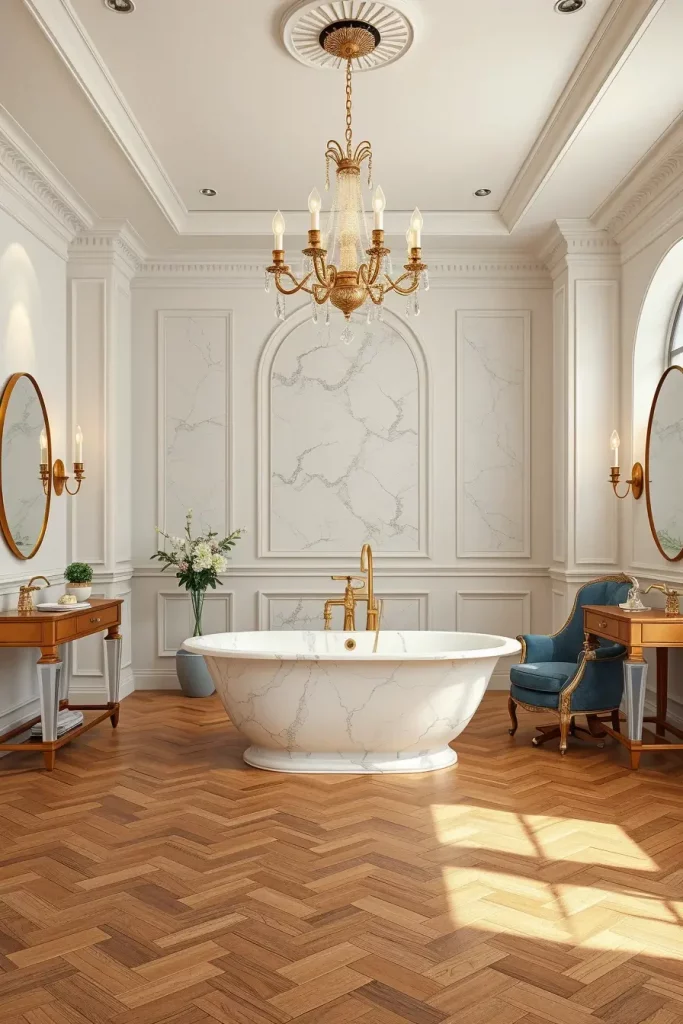
I often position these tubs near windows or chandeliers, atop contrasting tile or wood platforms. The surrounding decor blends antique and contemporary elements-wall moldings, brushed brass fixtures, fluted side tables, and velvet lounge chairs. A restrained palette of whites, grays, and metallics highlights the marble’s beauty. Oversized mirrors or wall paneling balance the space without overshadowing the tub.

Though heavy and high-maintenance, marble tubs deliver unmatched elegance. Veranda and House Beautiful consistently rank natural textures like marble among top spa bathroom trends. For comfort, ensure the tub is sealed and install underfloor heating to avoid cold feet. A freestanding caddy with crystal decanters or bath oils completes the scene.
Master Suite Sanctuaries: Freestanding Tubs as Luxurious Retreats
Integrating a freestanding tub into a master bedroom suite creates a seamless blend of rest and rejuvenation, evoking the feel of a luxury resort.

I place tubs near oversized windows or fireplaces, surrounded by soft carpets and plush seating. Warm color schemes-taupe, cream, charcoal-create a cozy atmosphere. Accessories like wooden bath trays, linen screens, and woven baskets add texture. Matching furniture such as tufted chaises or low benches reinforce the connection between bathing and sleeping areas.
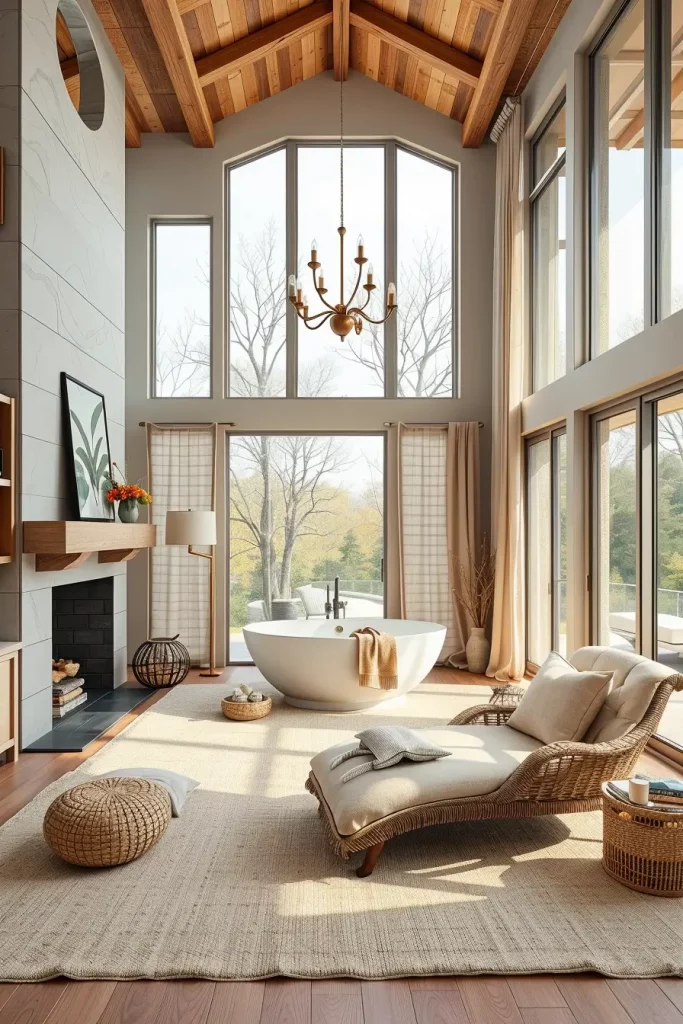
This design suits couples prioritizing self-care or remote workers seeking daily respite. Luxe Interiors + Design features suites where freestanding tubs serve as architectural focal points, promoting mental calm. To enhance versatility, I recommend integrating smart home controls for temperature, lighting, and sound, along with adjustable privacy curtains.
Whether you’re drawn to minimalist serenity or bold artistic statements, these freestanding tub styles prove that relaxation and style can coexist beautifully. Perhaps these ideas will inspire you to reimagine your bathroom as a personal retreat rather than a mere utility space. Which design resonates most with you? Share your thoughts and favorite looks in the comments-I’d love to hear your perspective.


